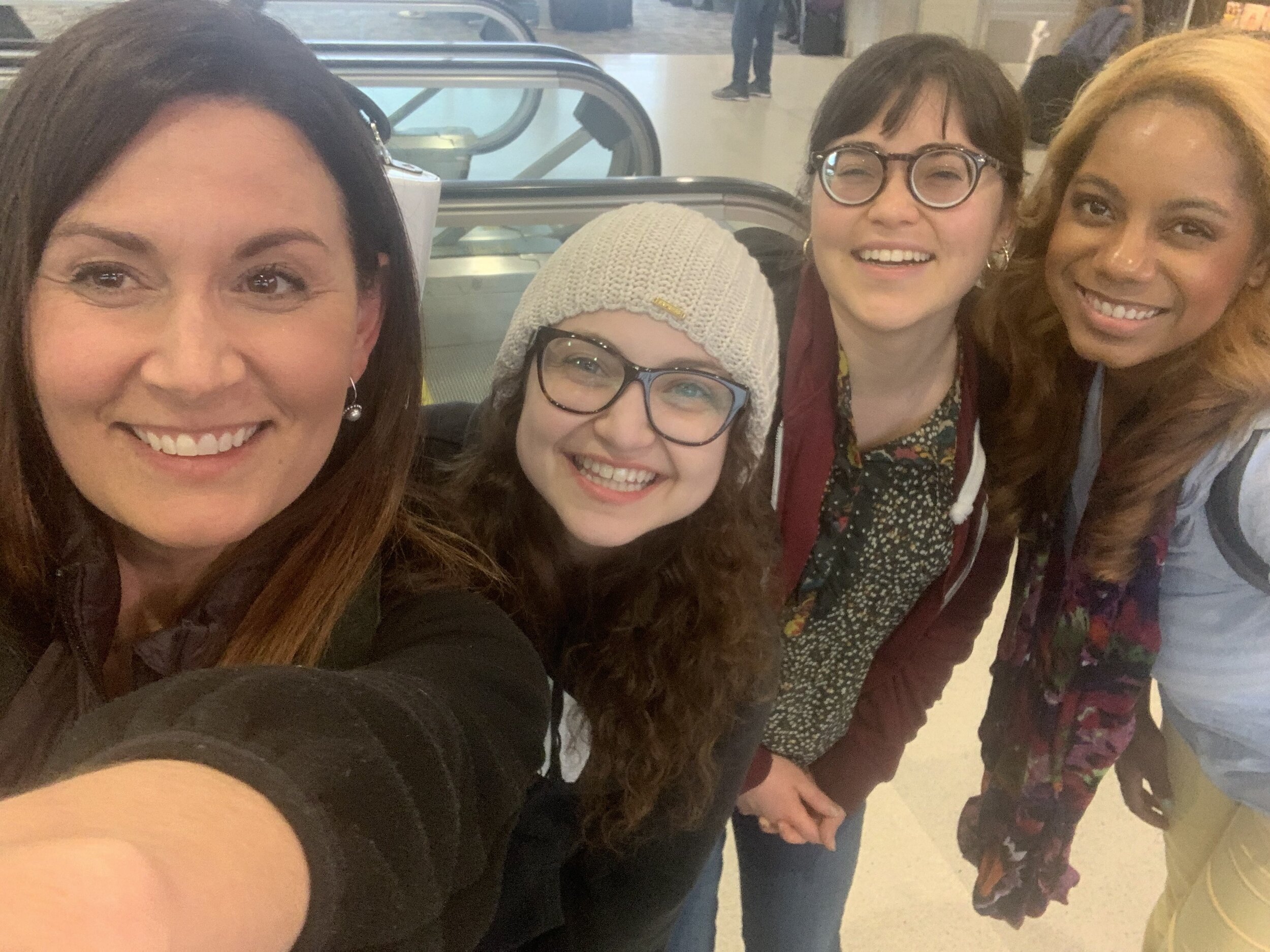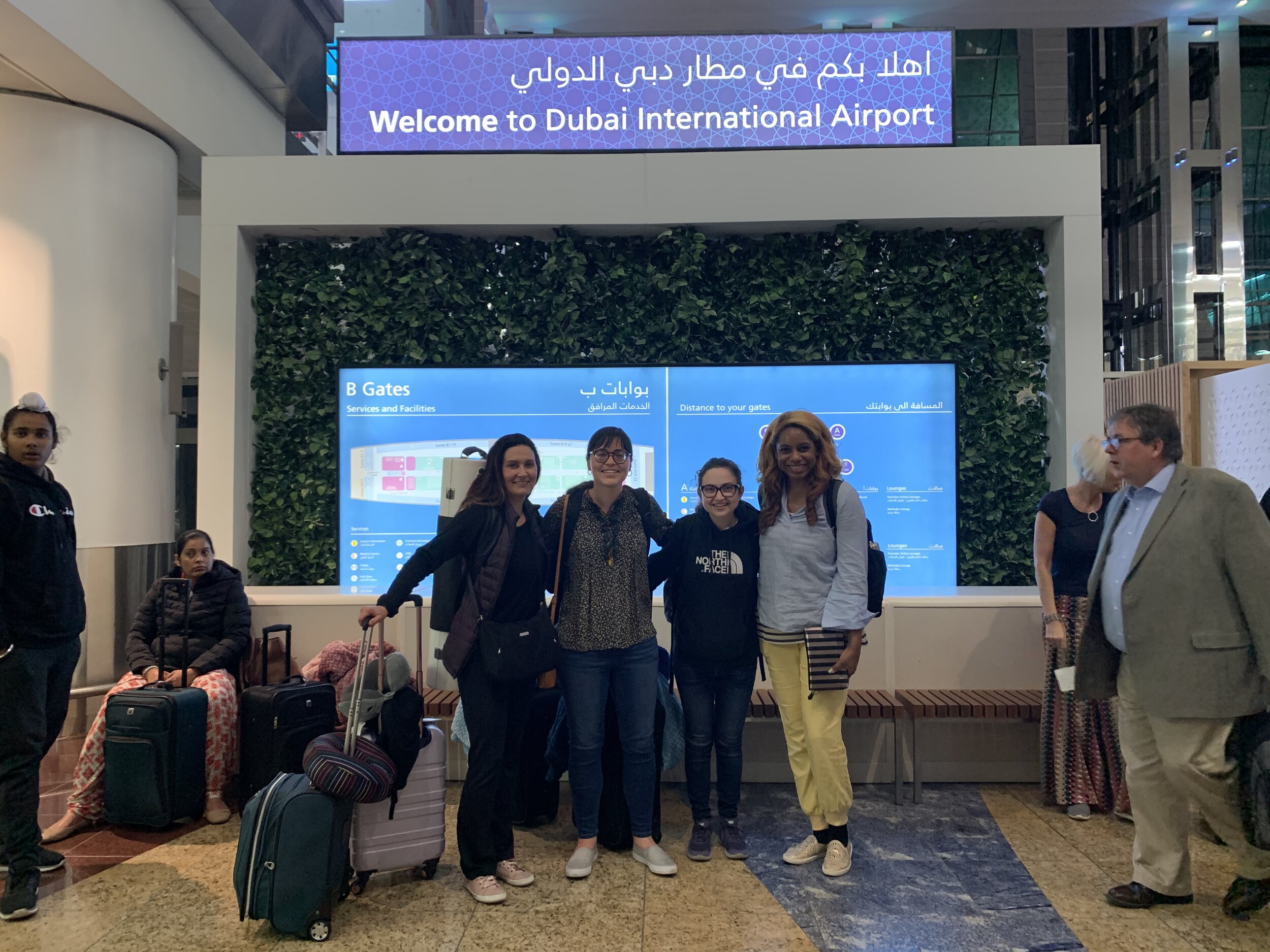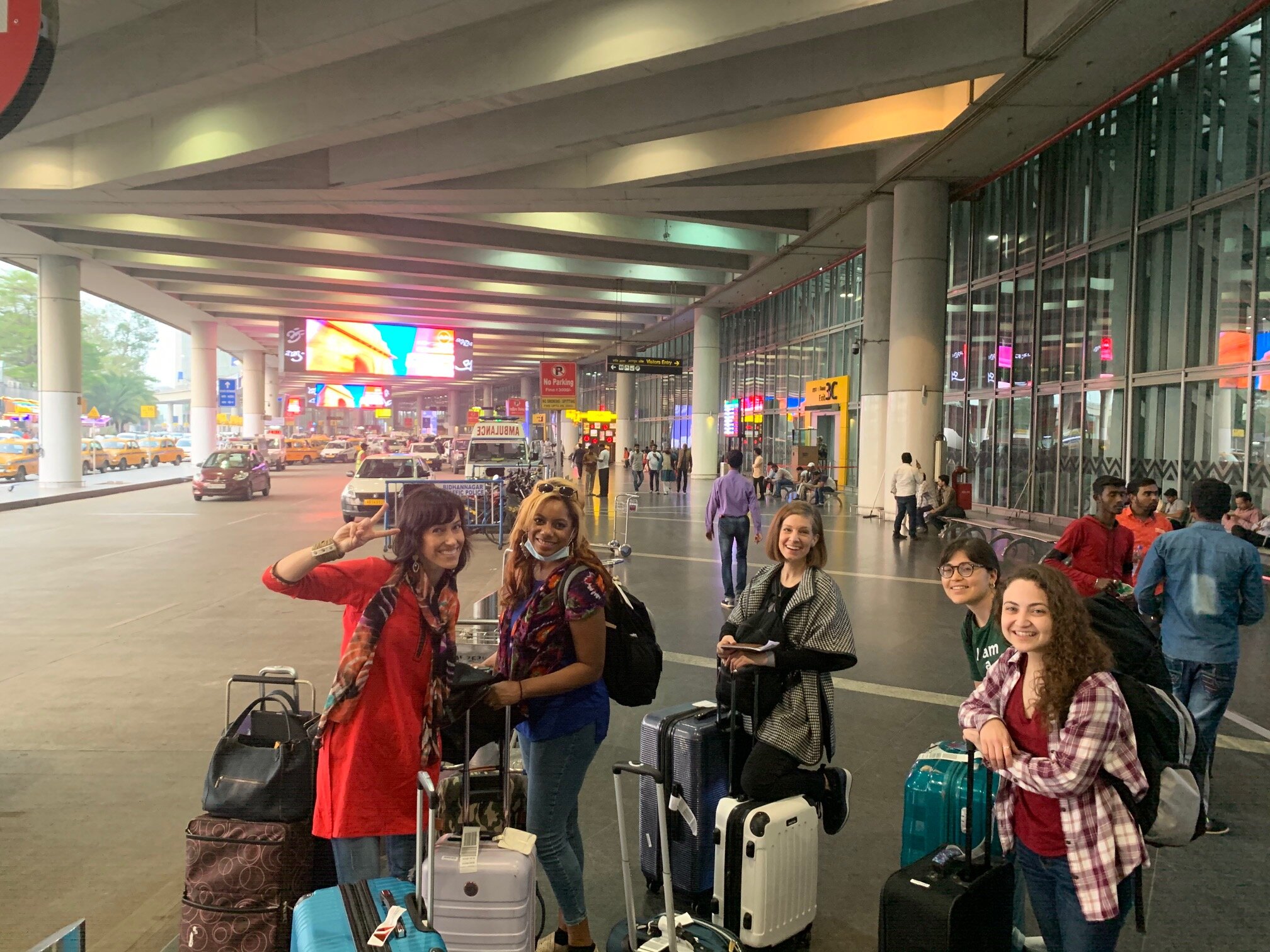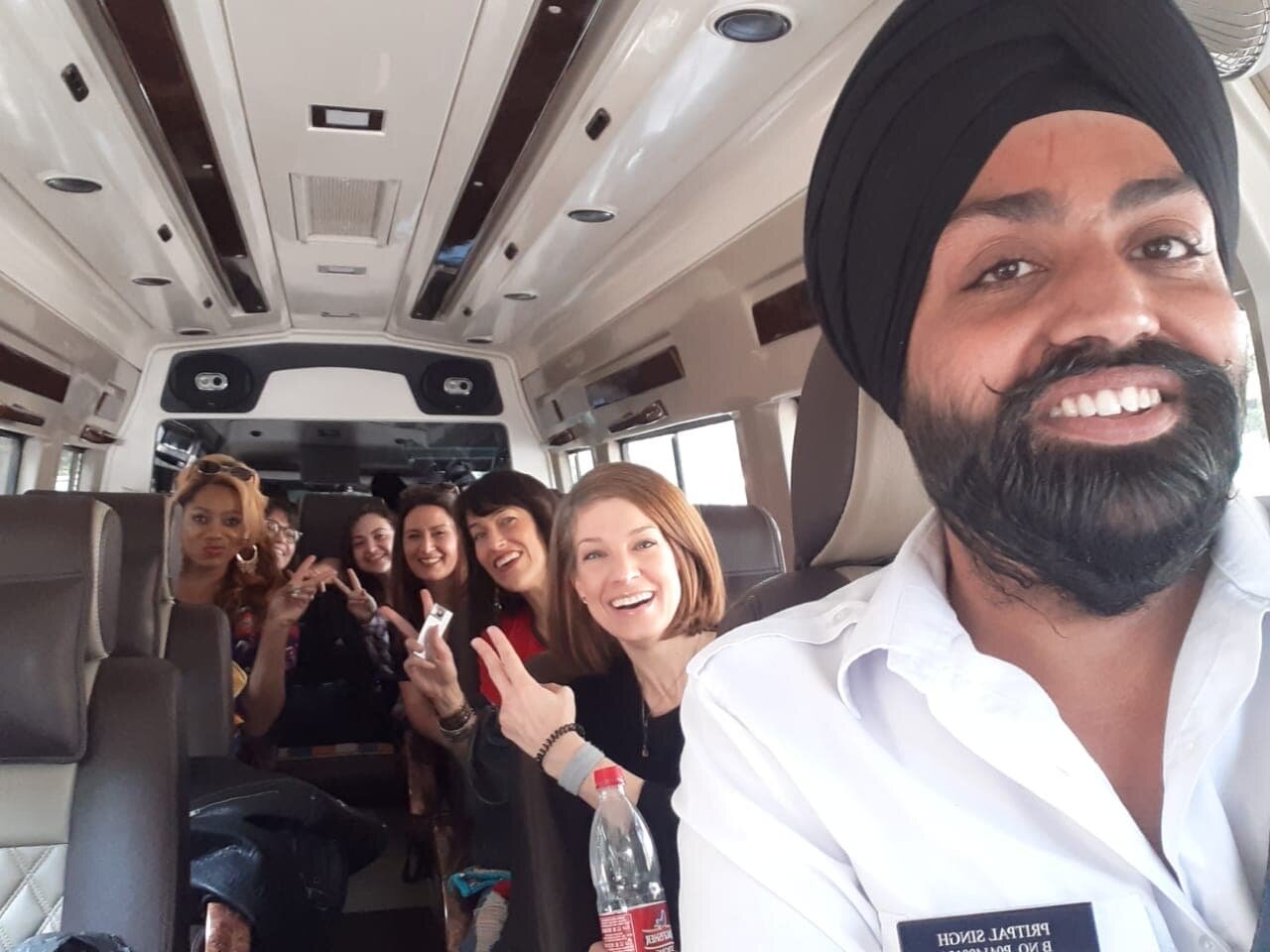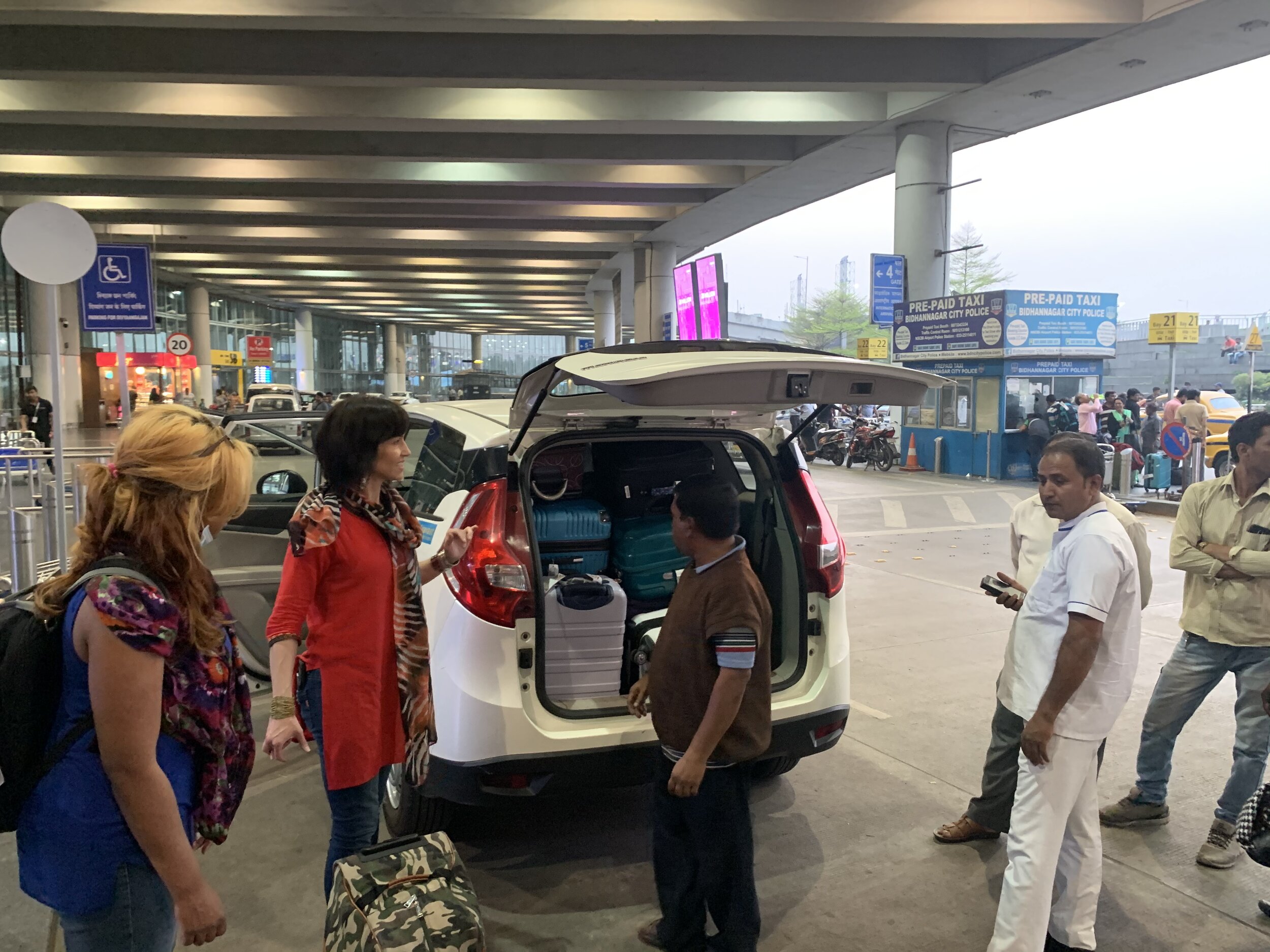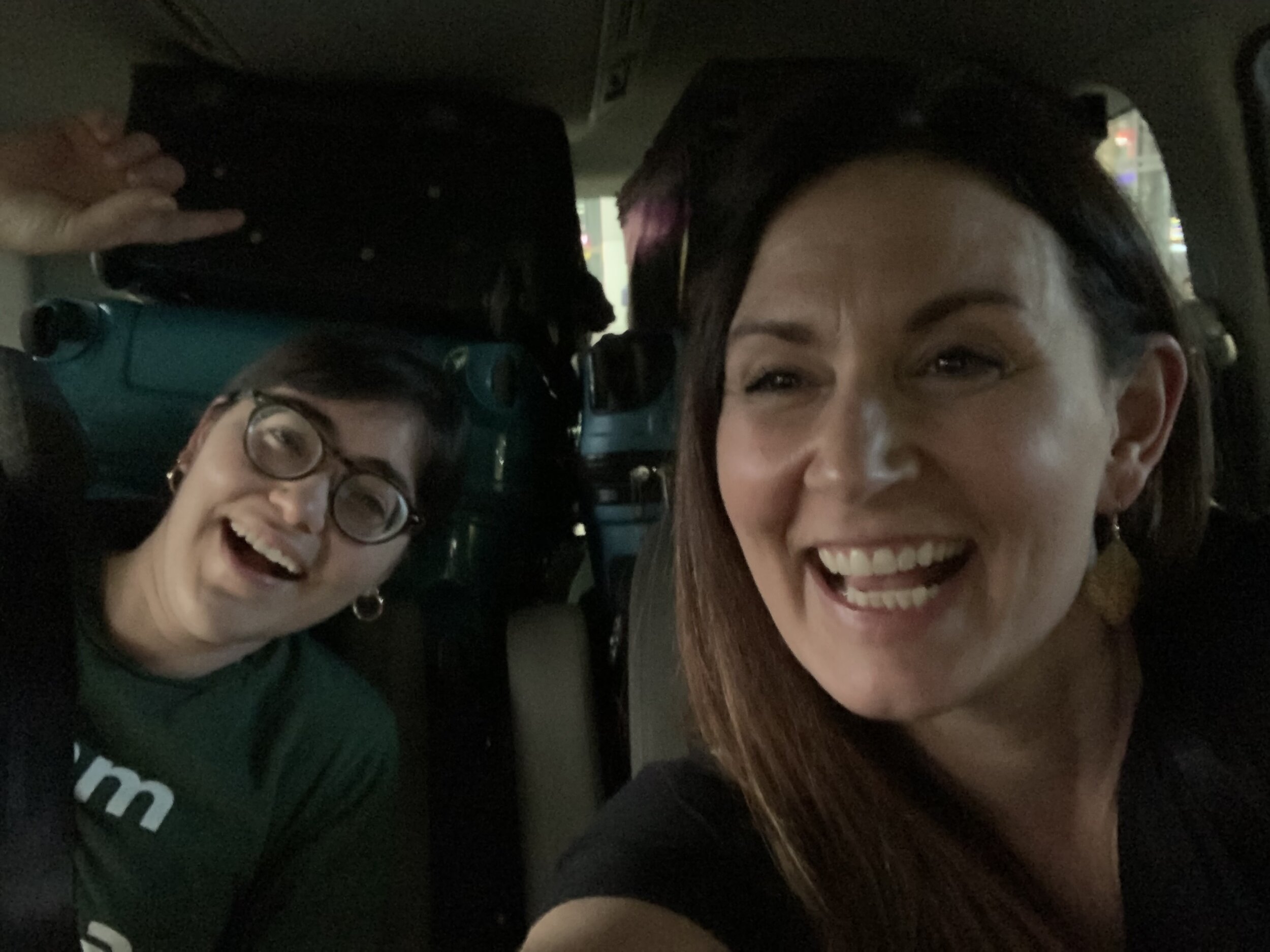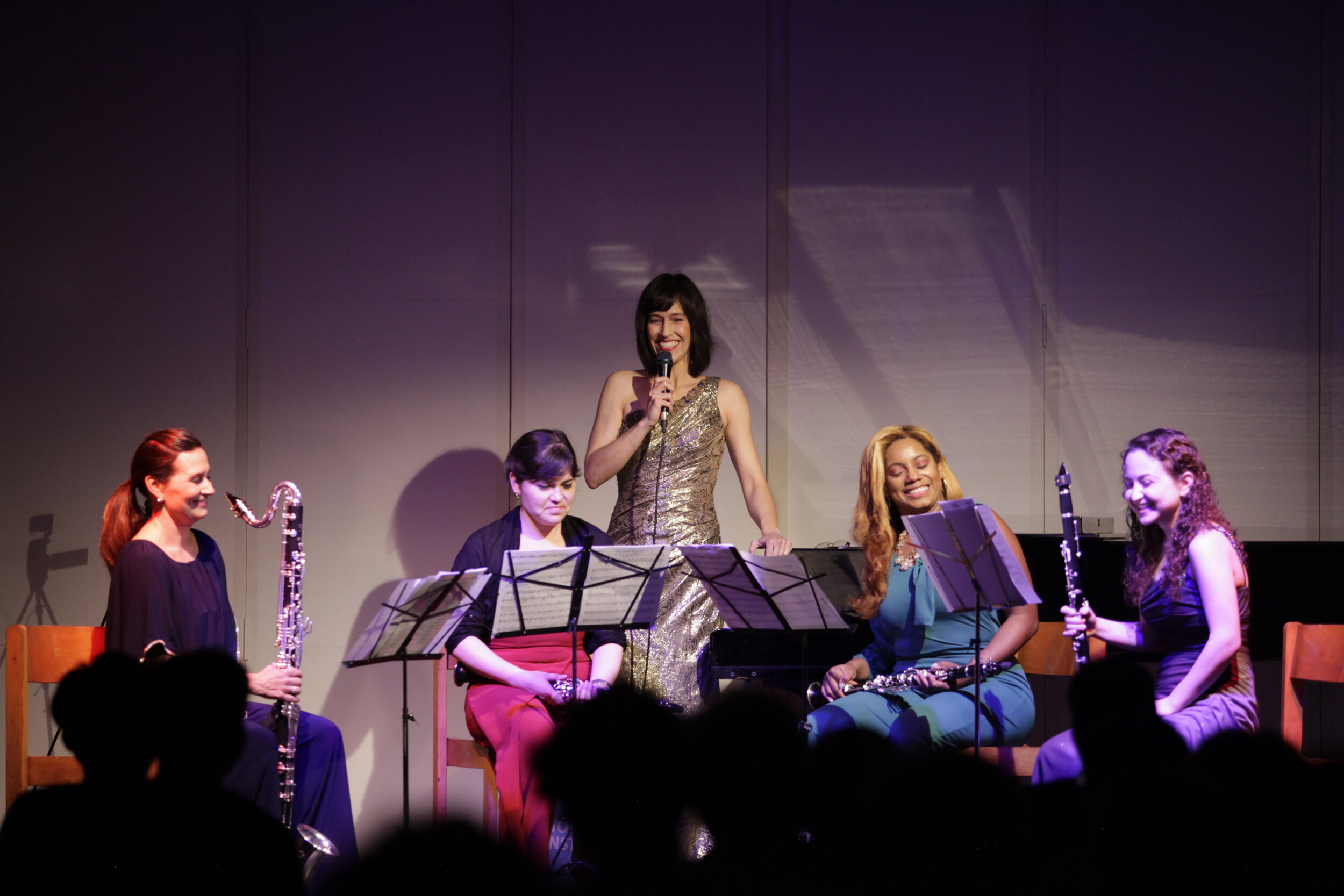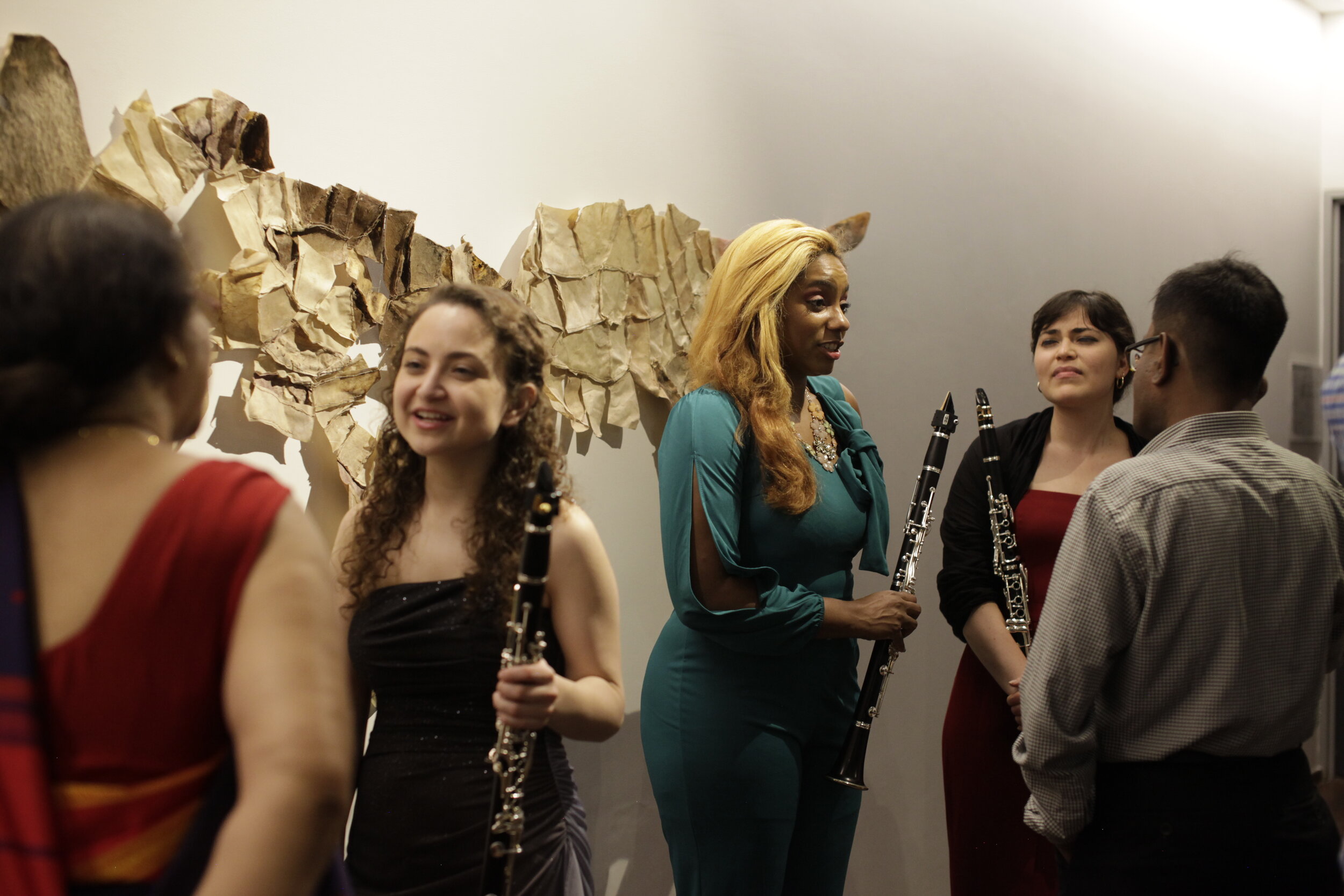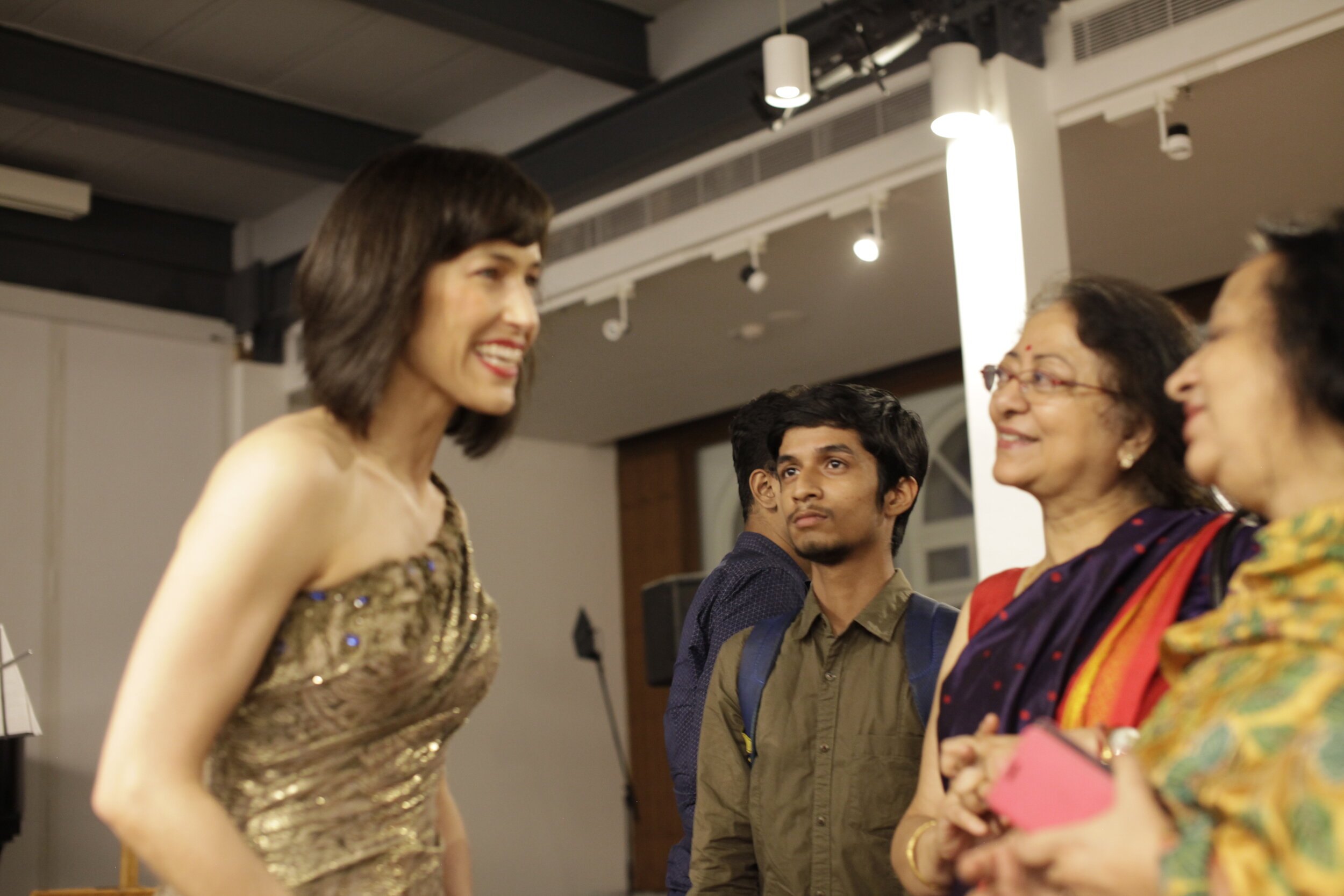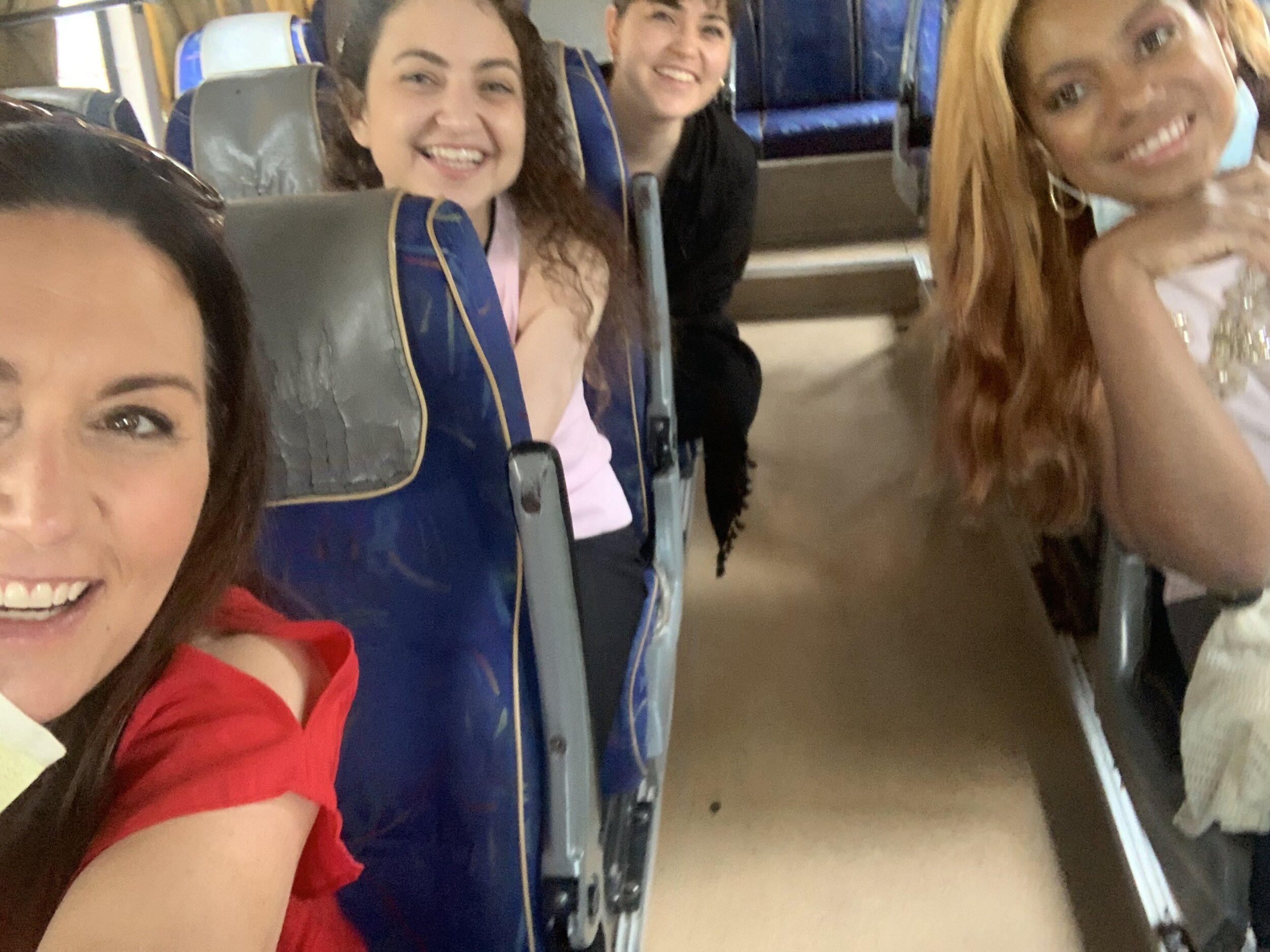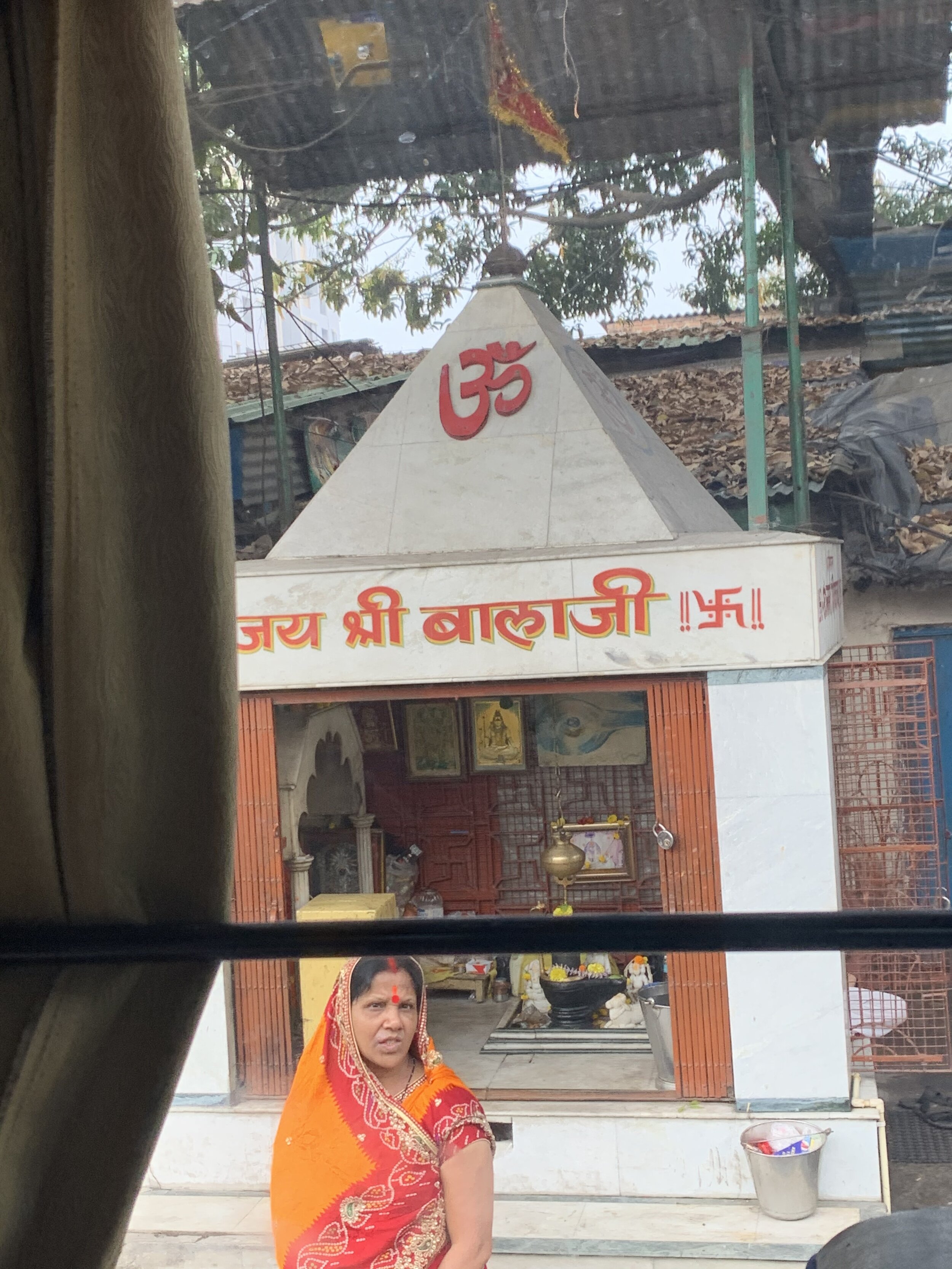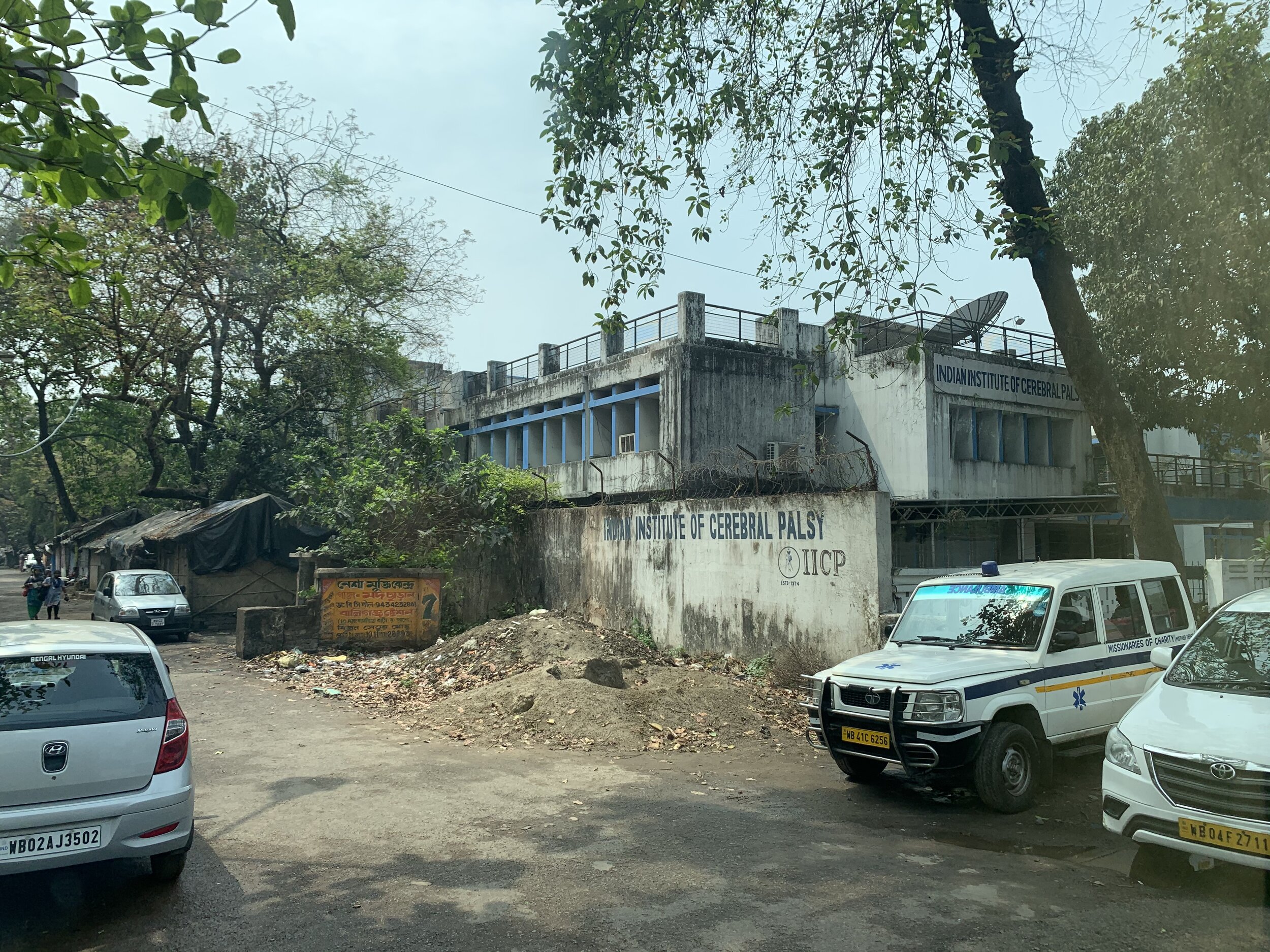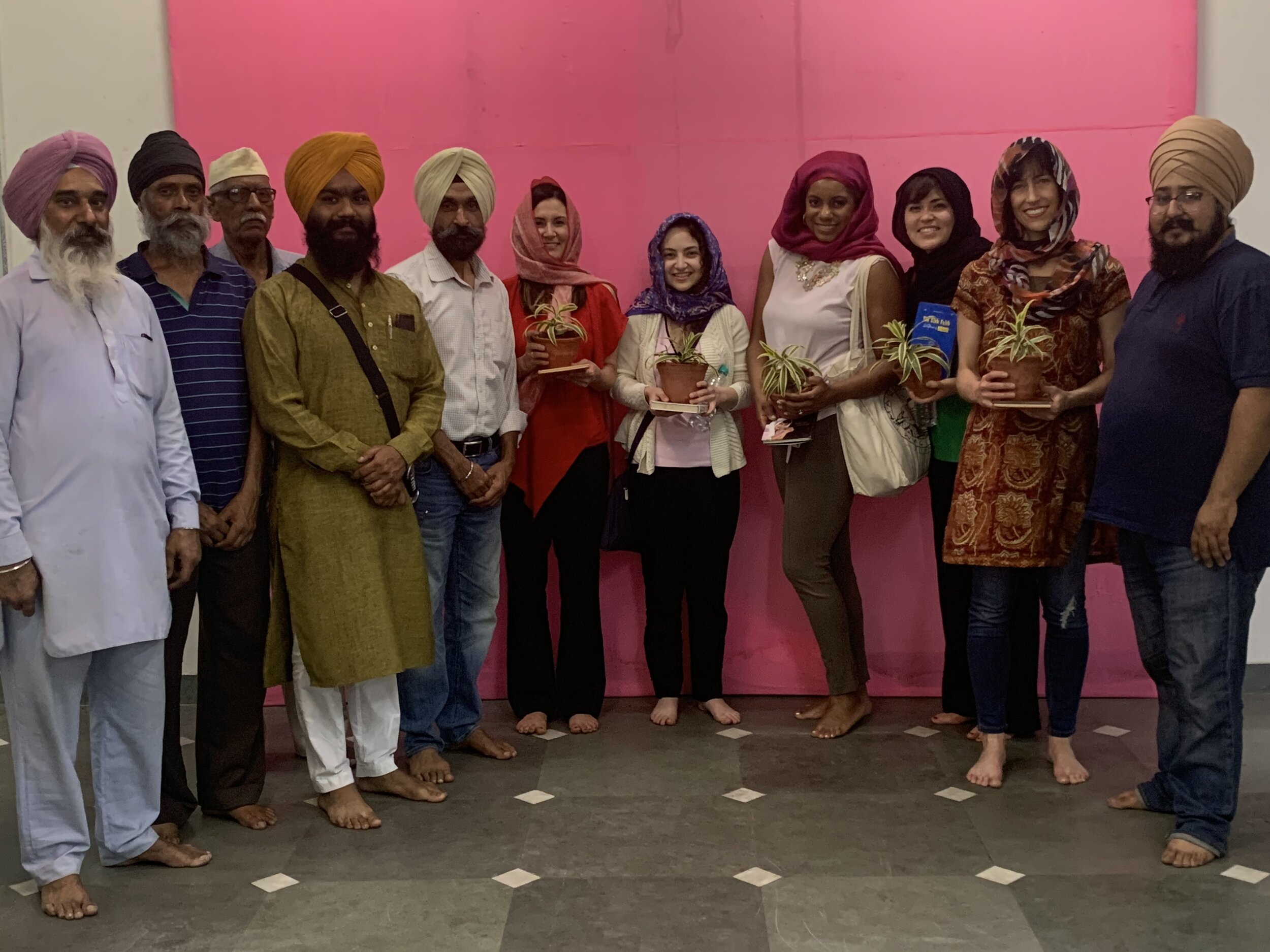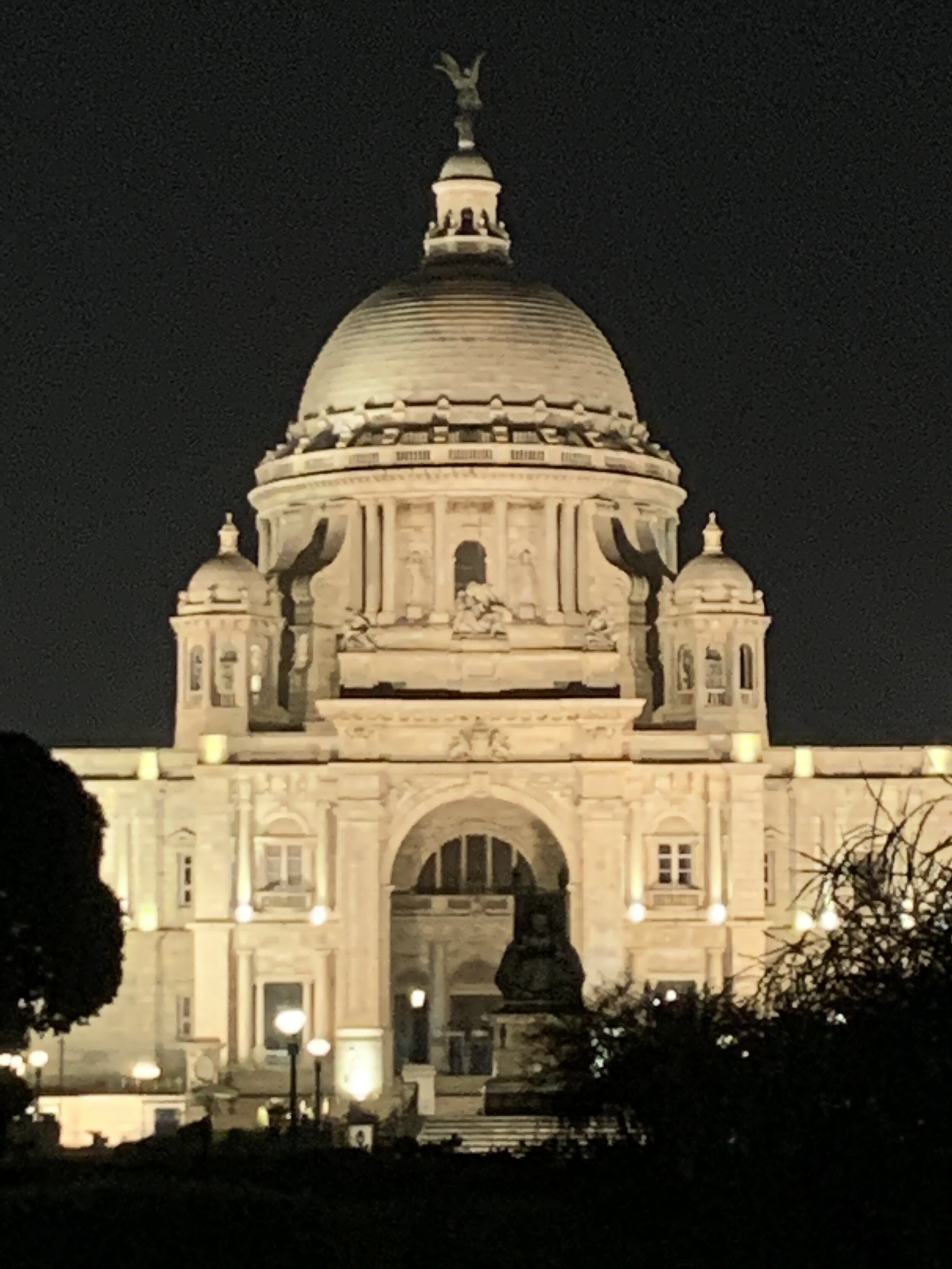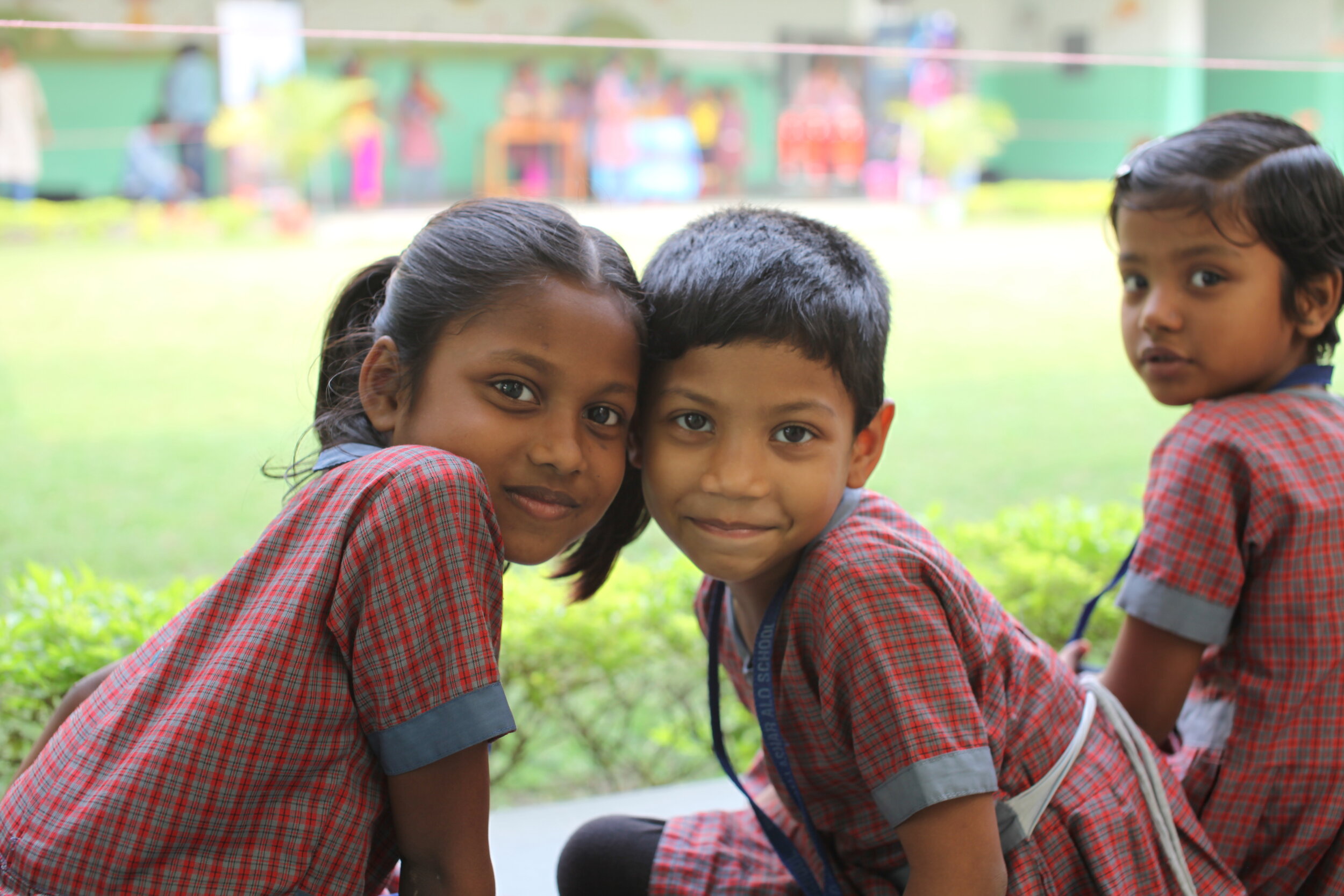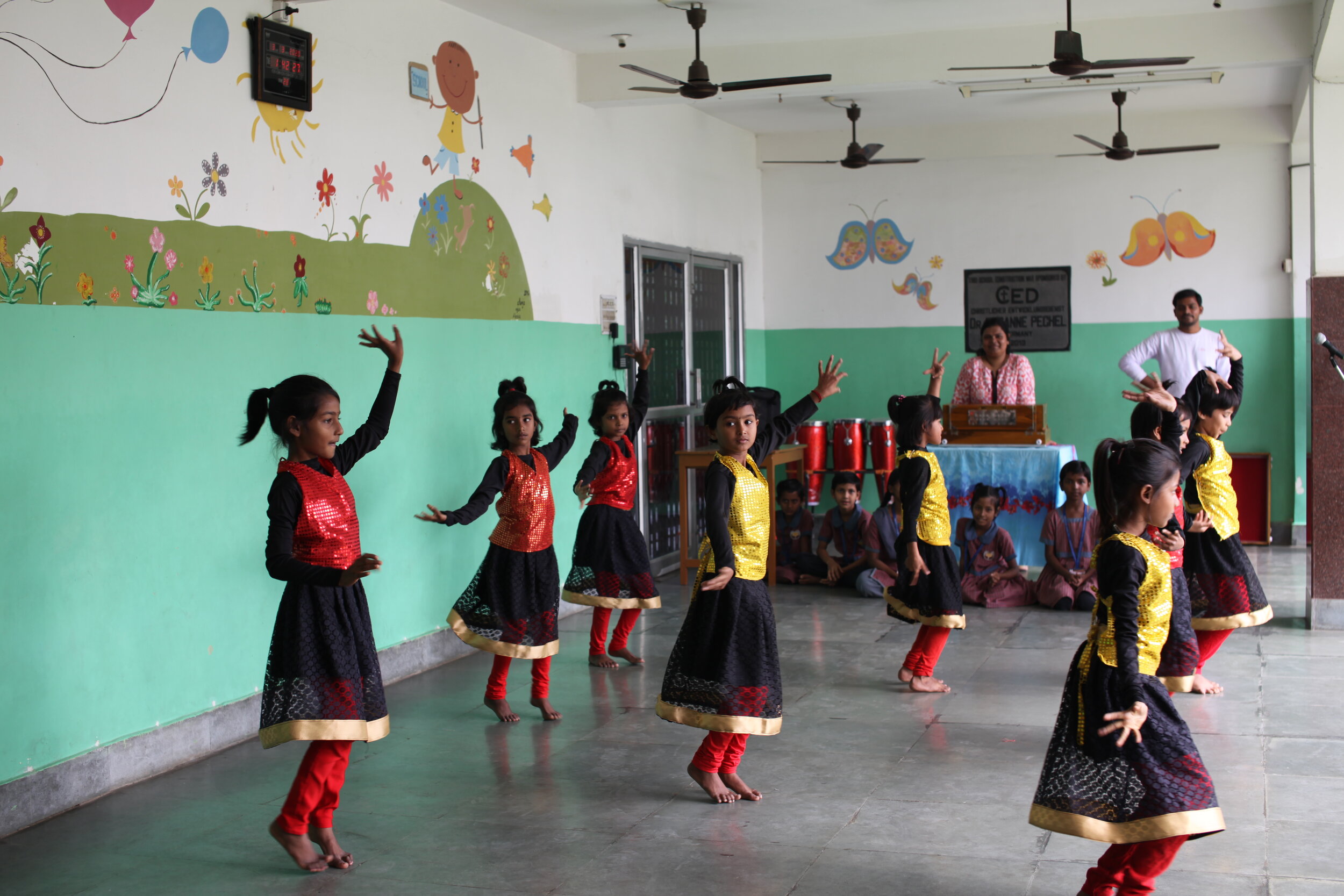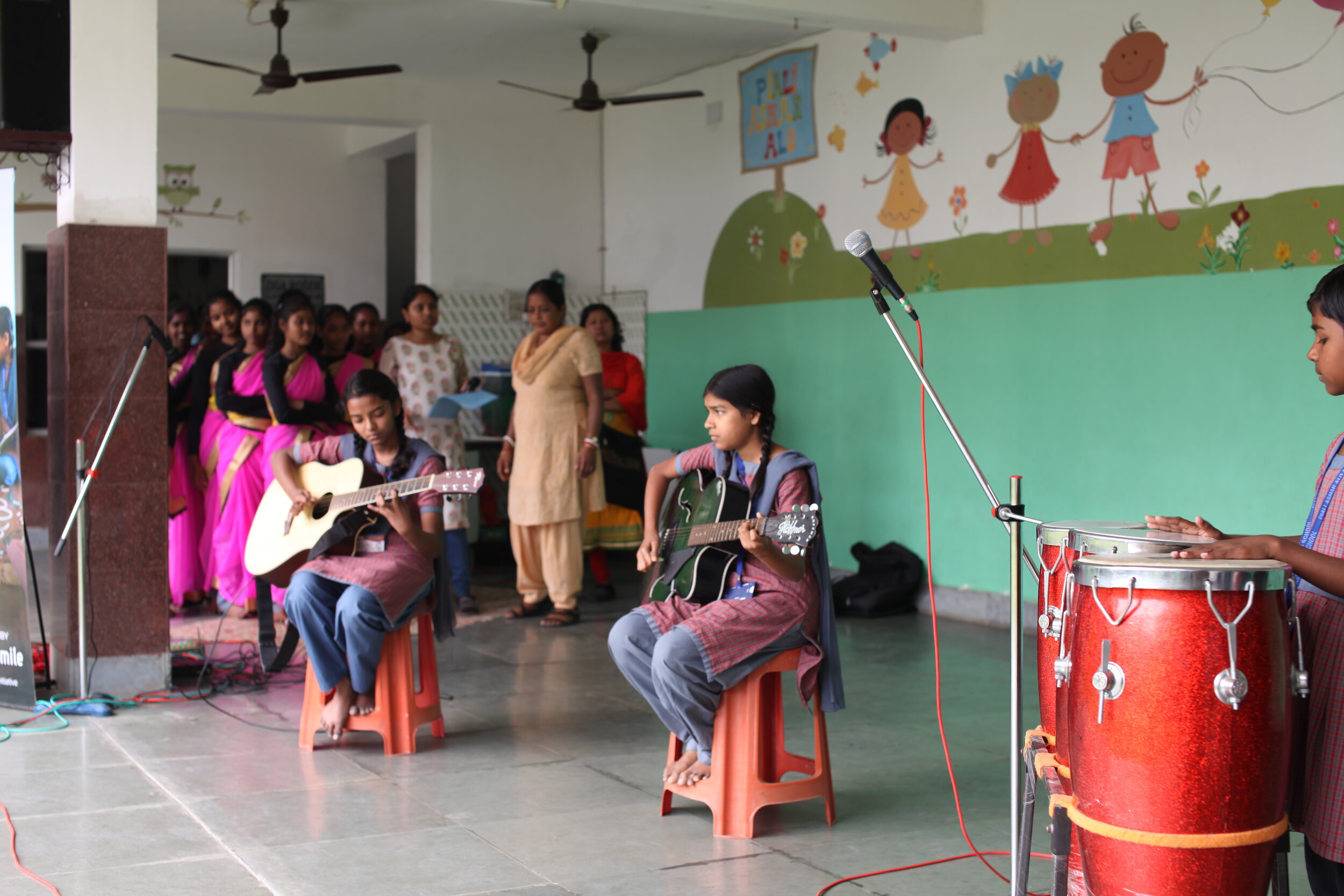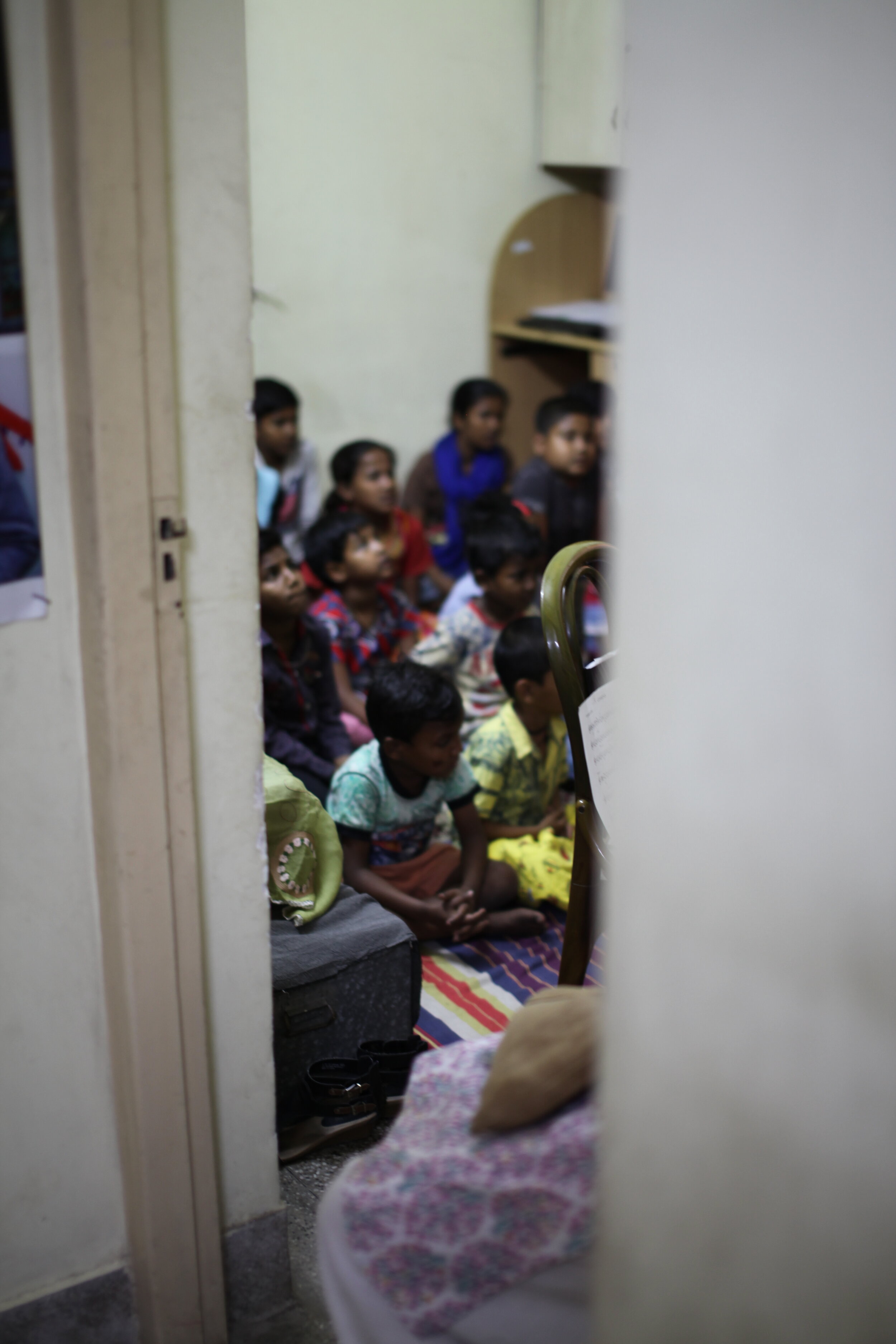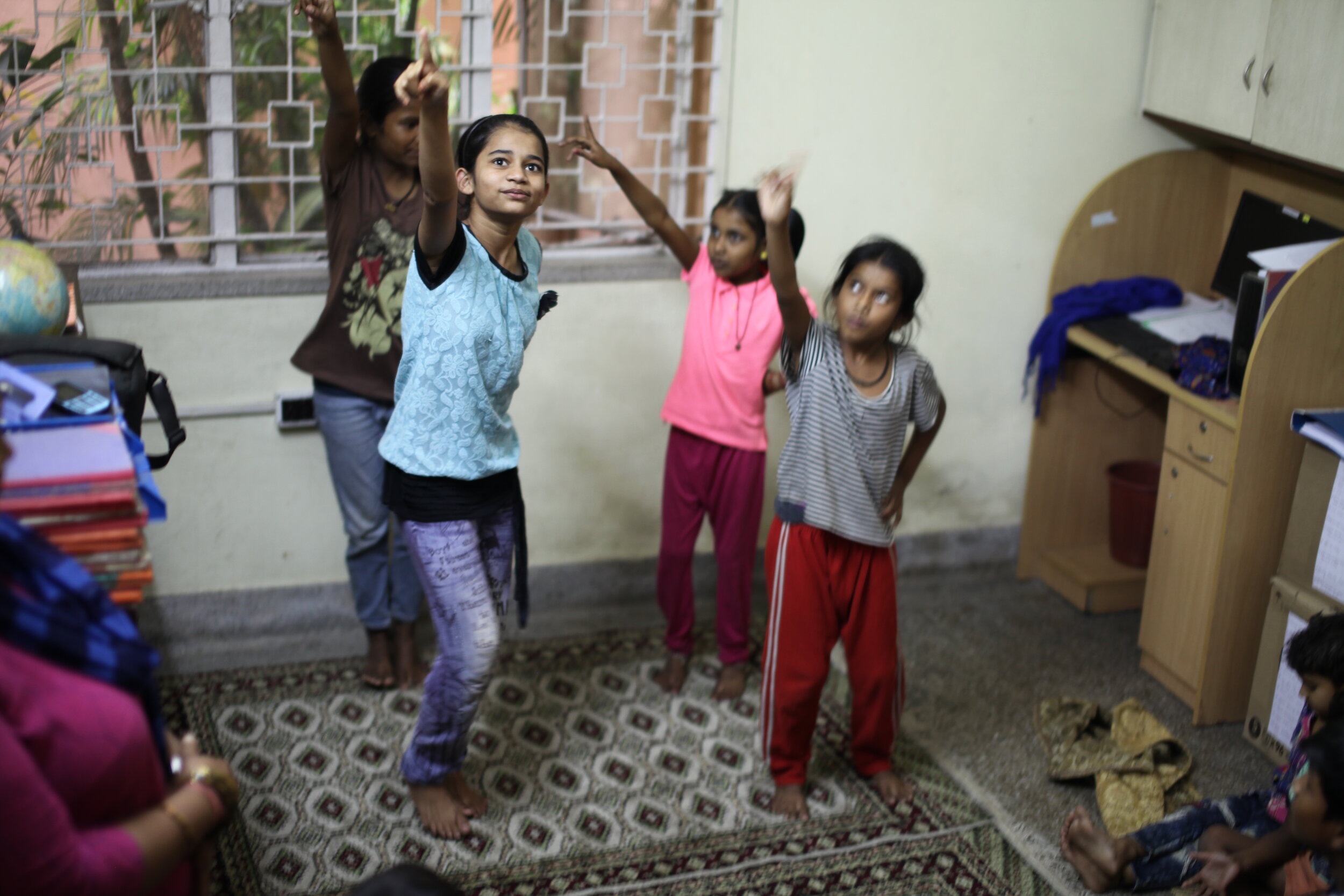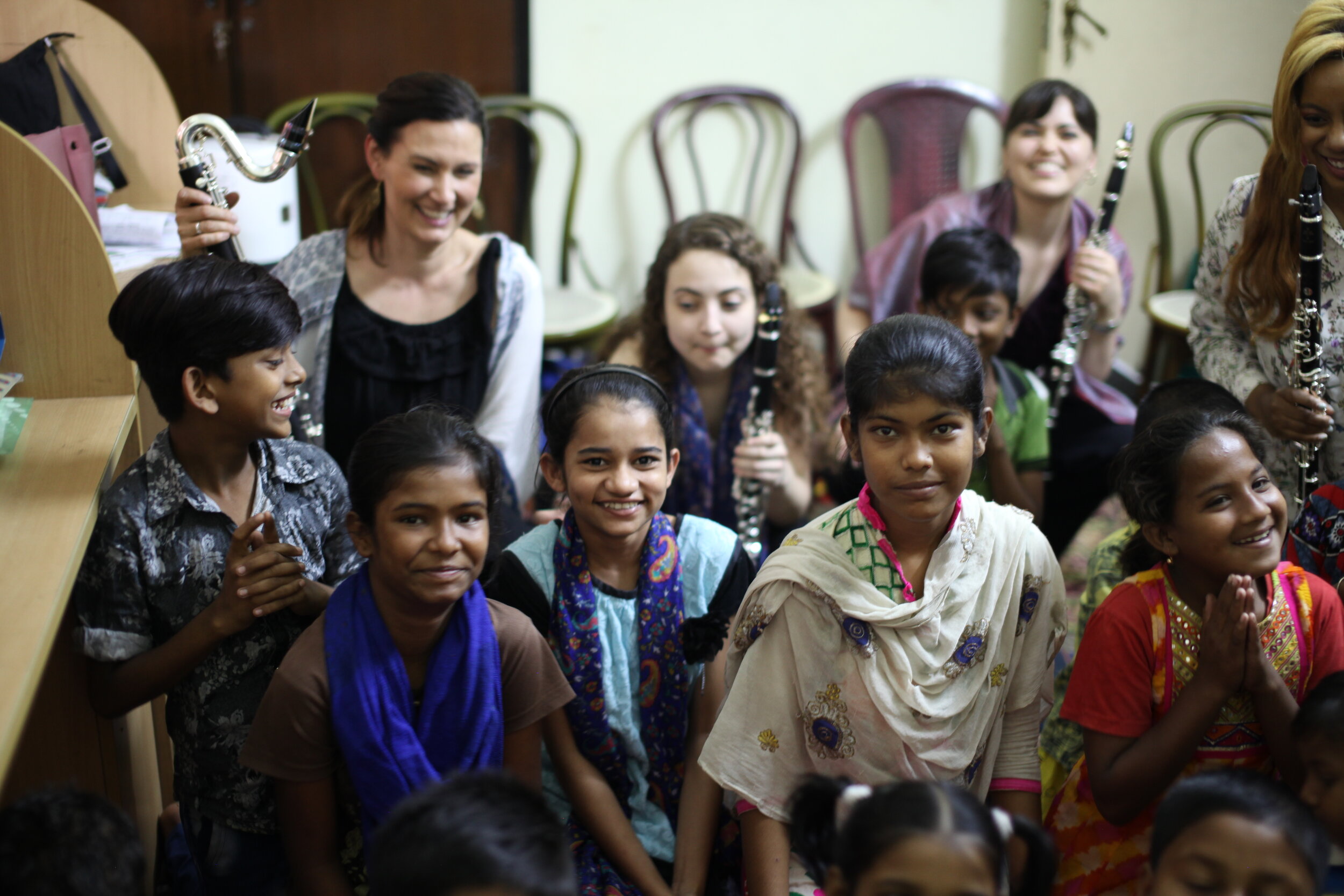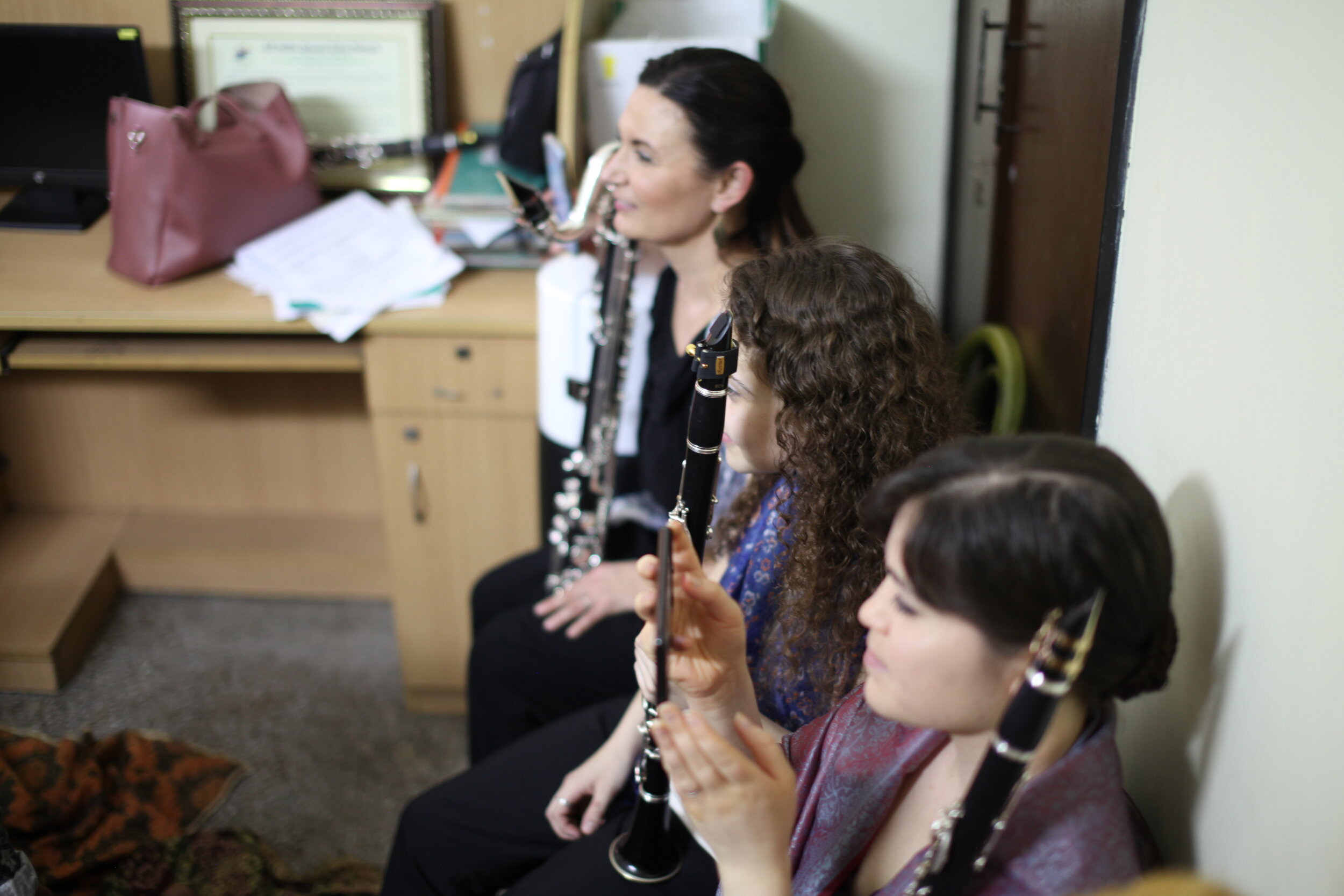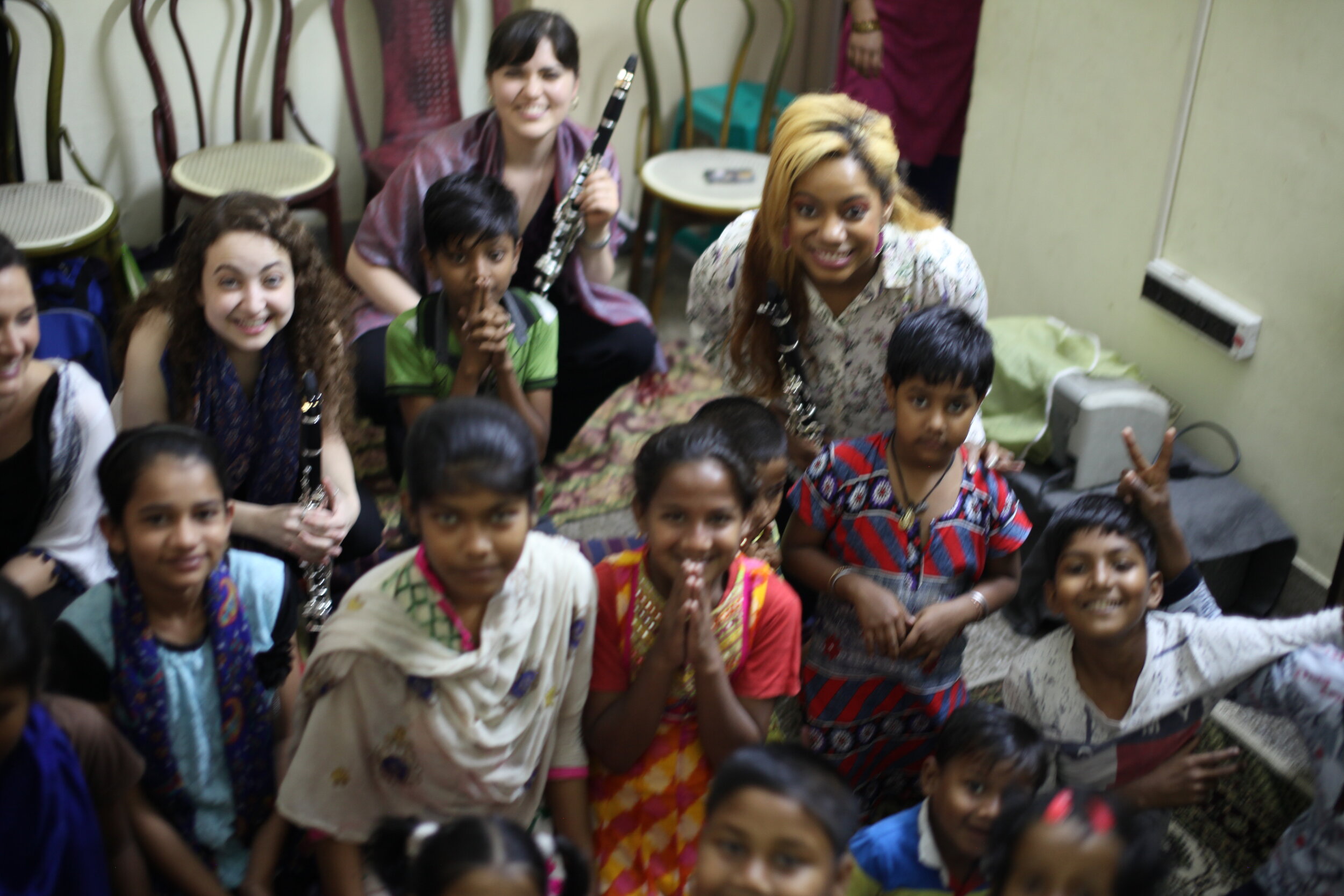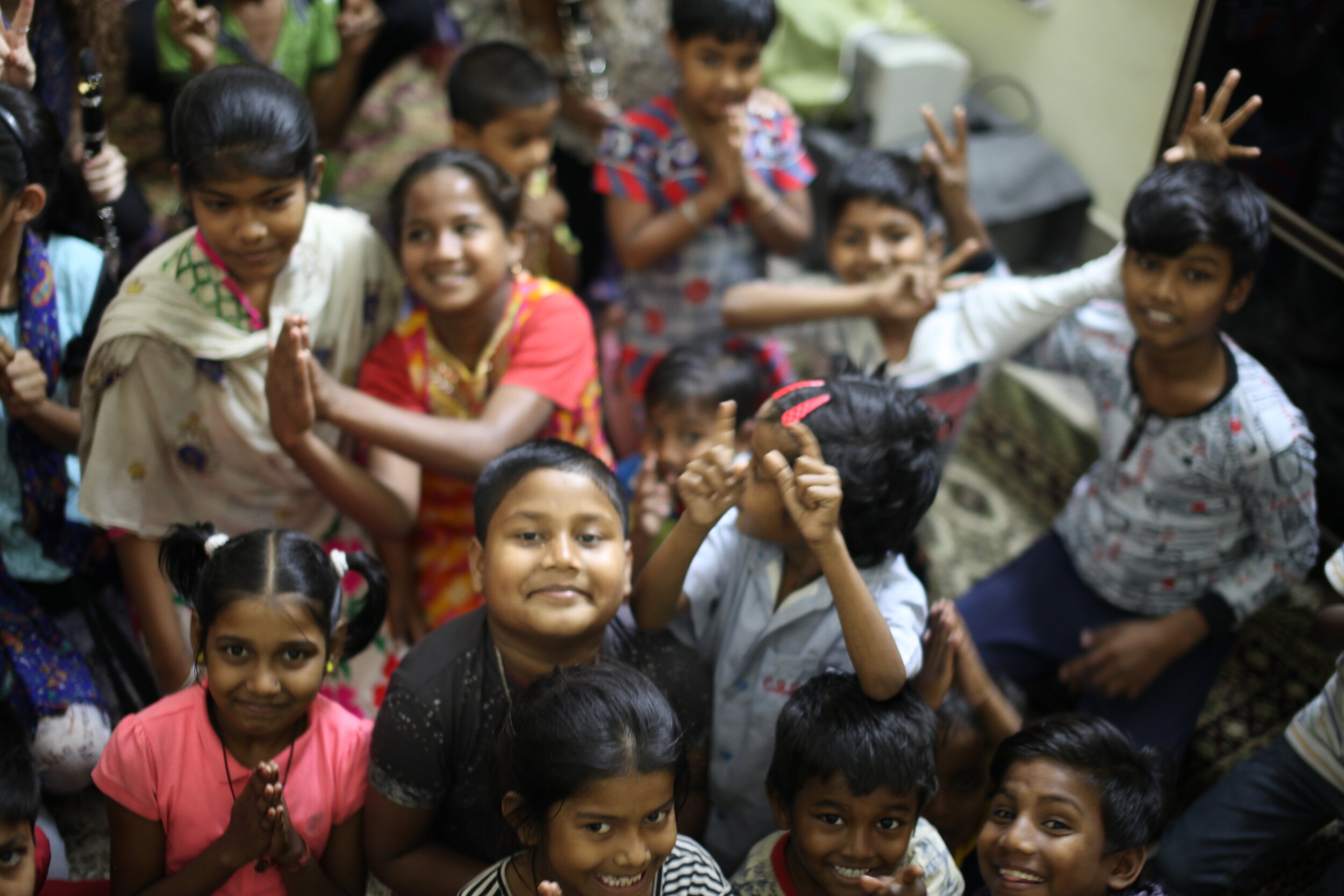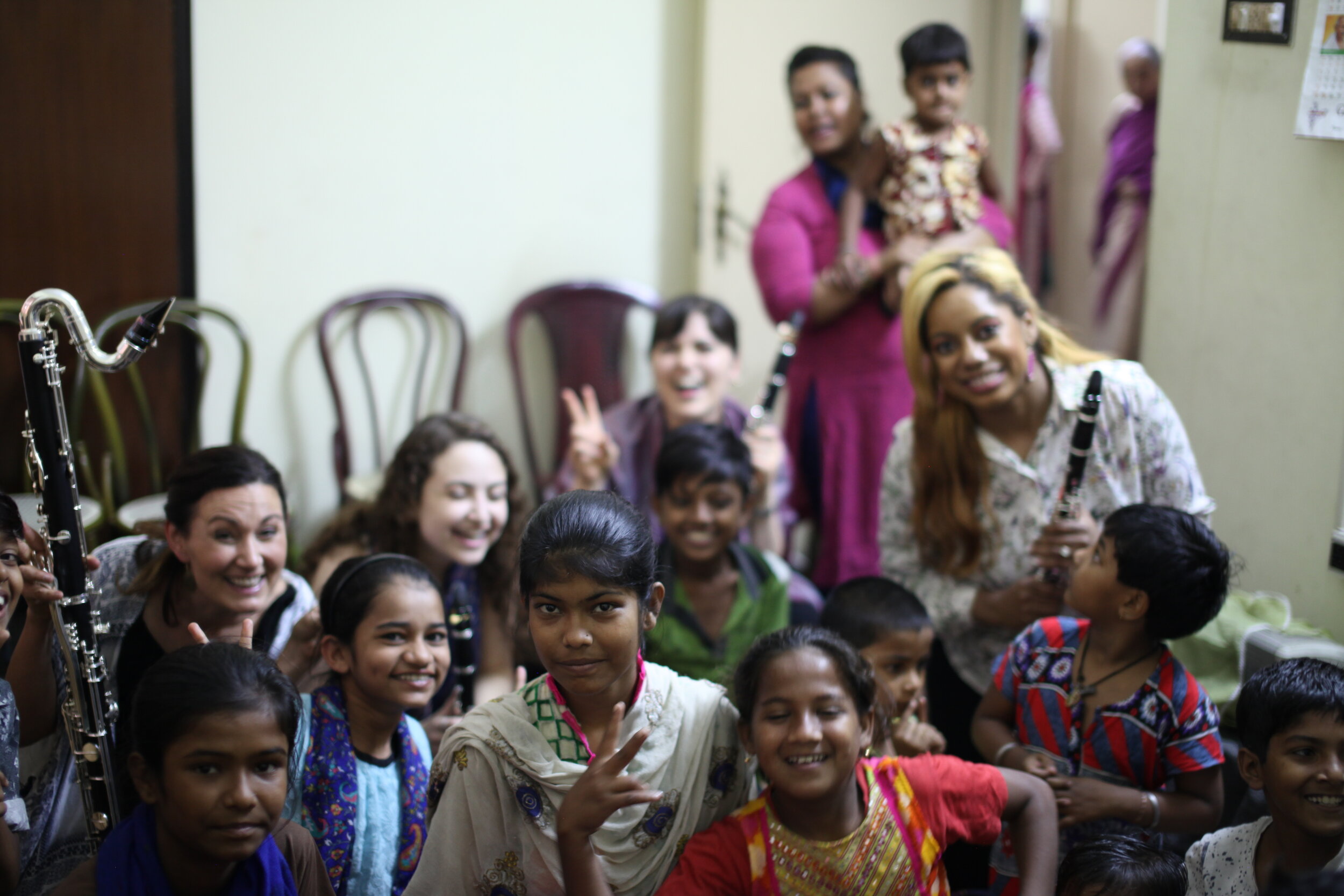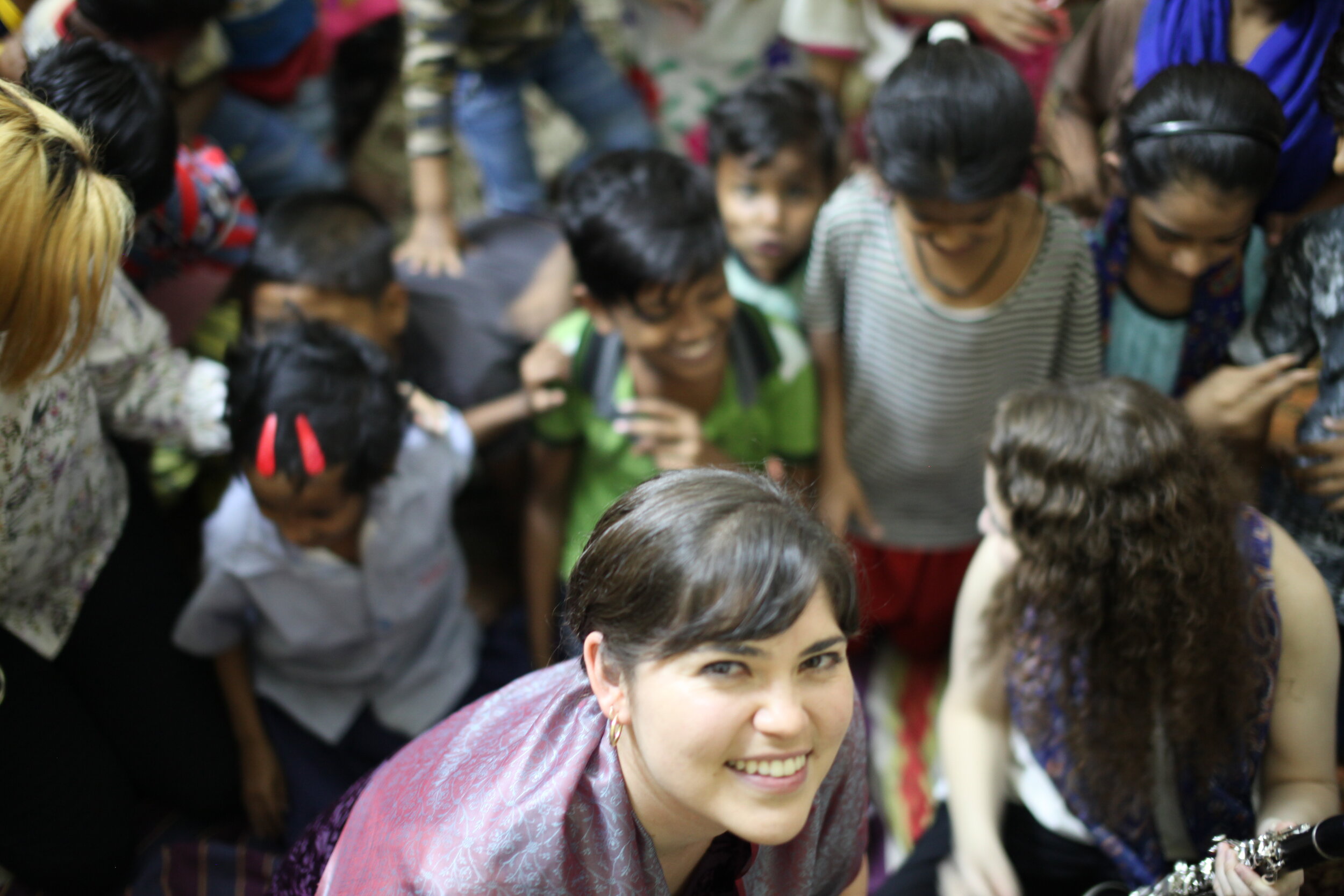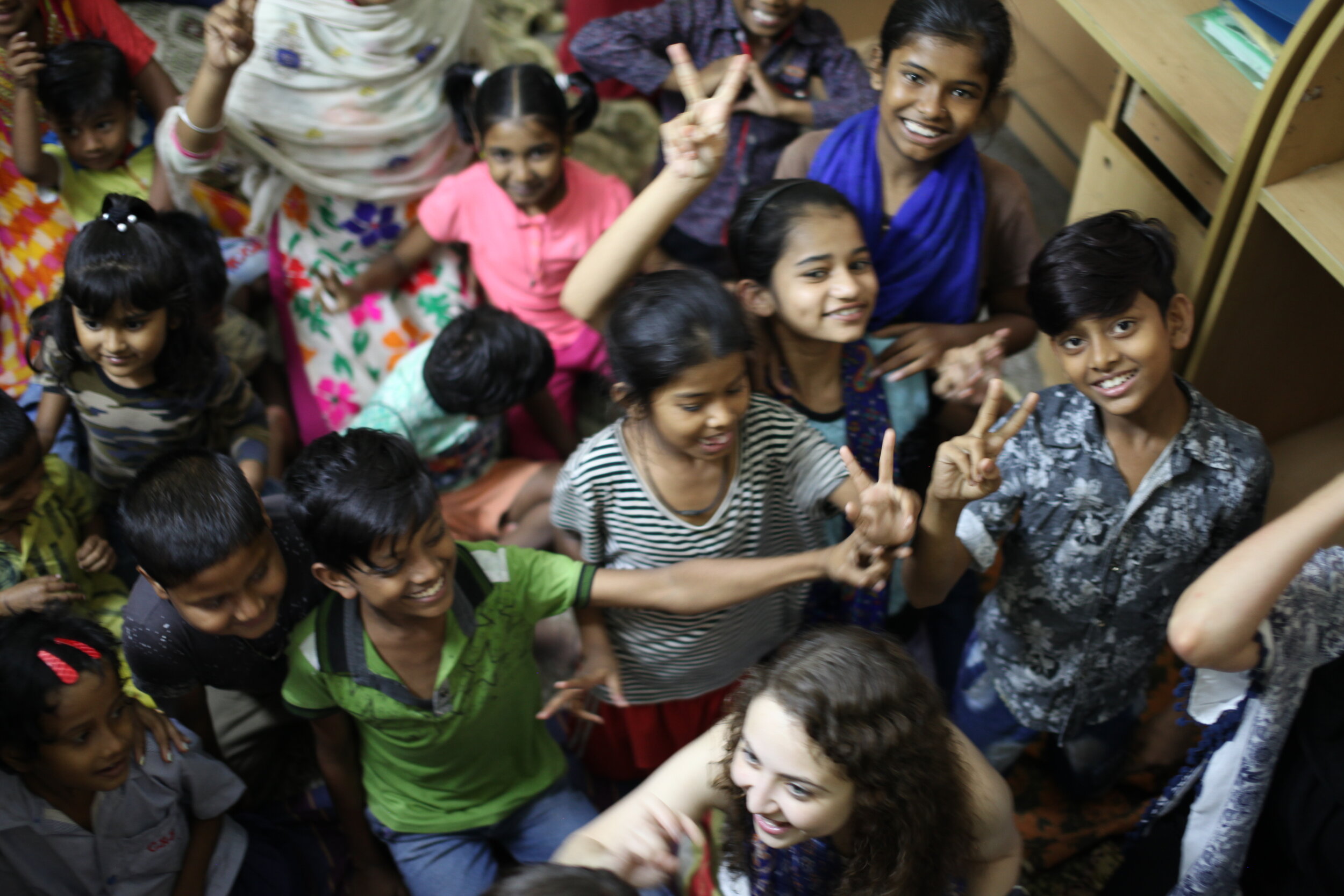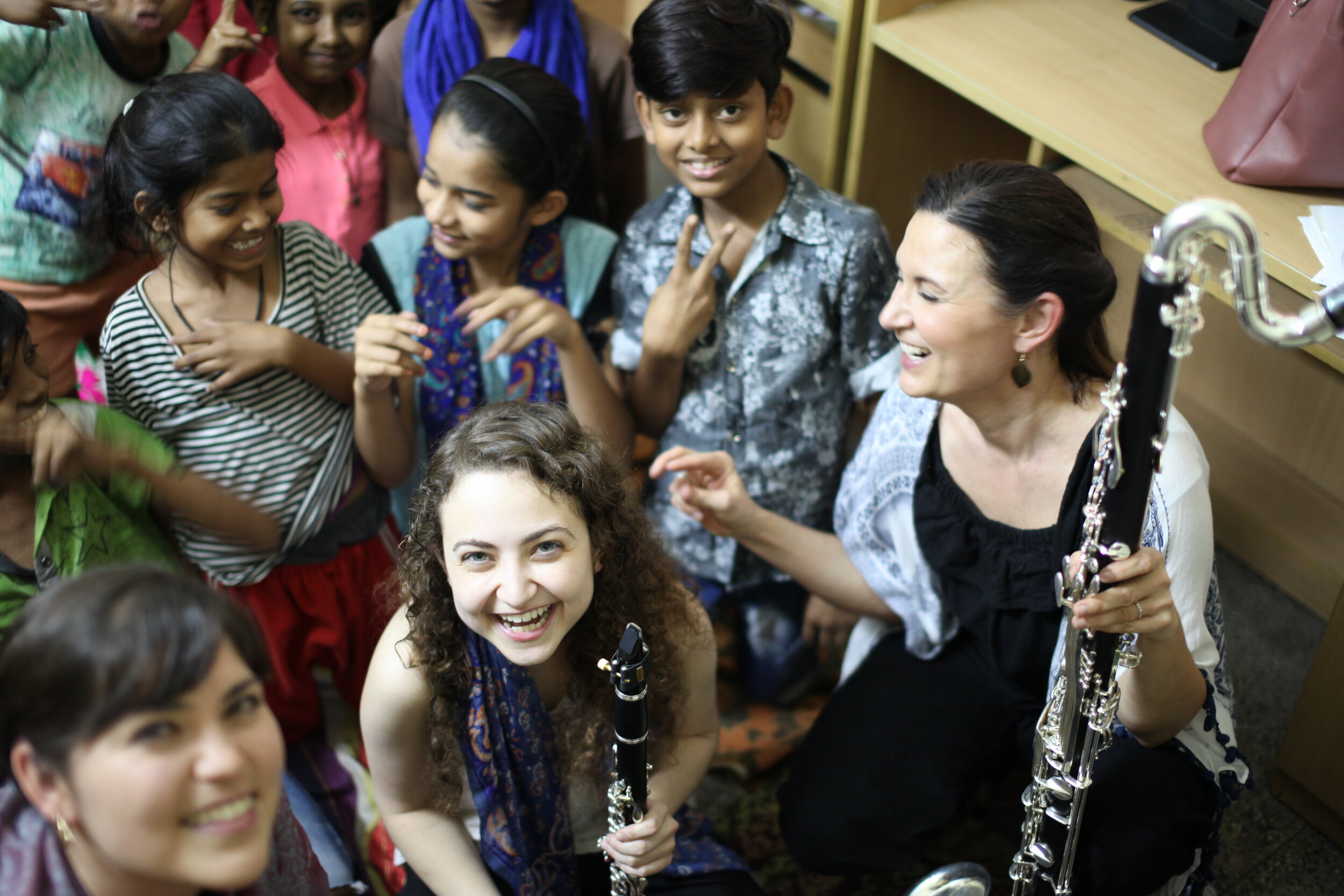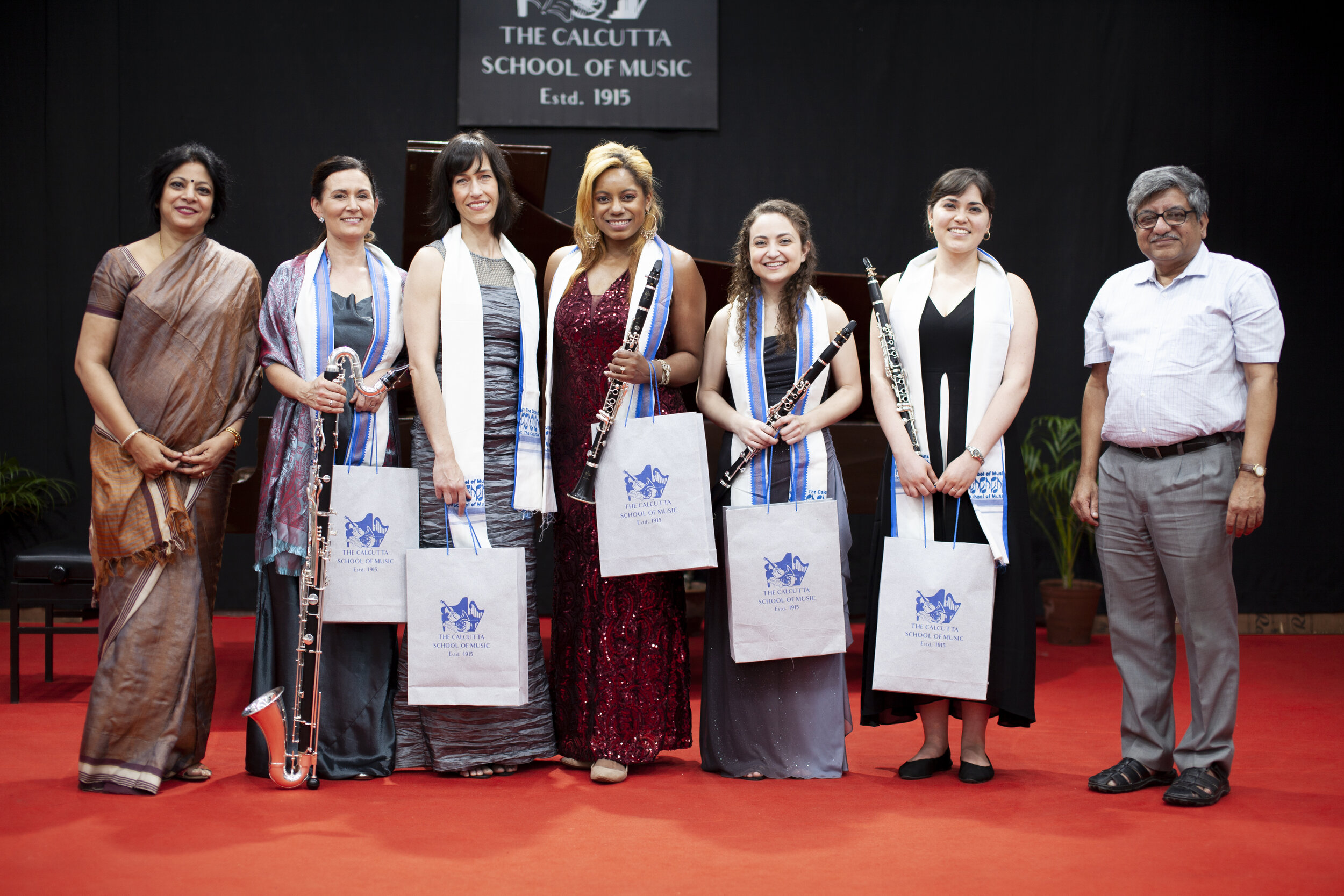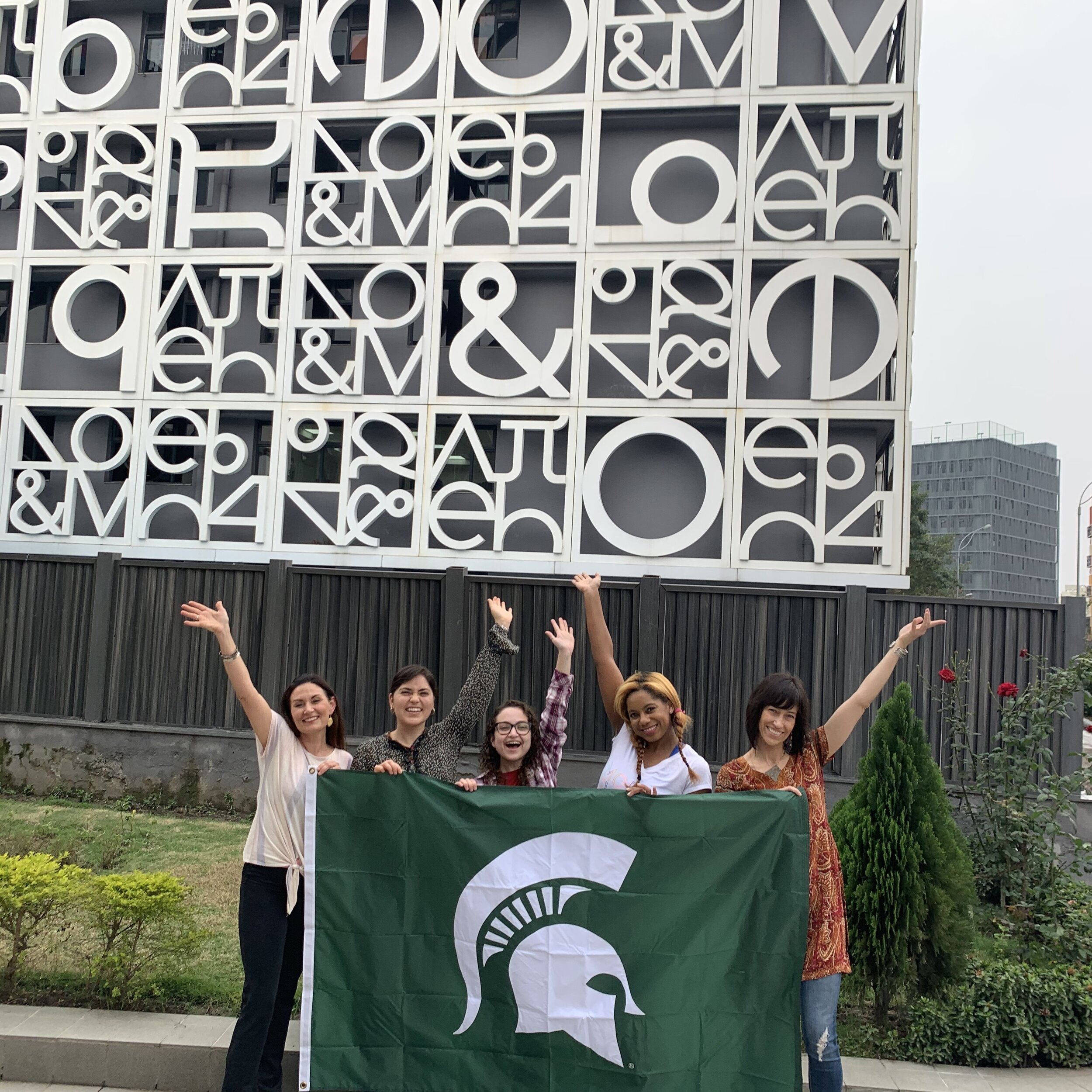Planes, Trains, and Clarinets - Spartans in India
MSU Study Abroad to India, March 2020
http://www.pitchpipefoundation.org/music-connects-worlds-before-slipping-into-a-coma.html
Music Connects Worlds Before Slipping into a Coma
There is a certain arrogance that accompanies a reliance on freedom- especially “American” freedom. Until recently, lack of freedom to travel and see the world sounded as foreign to me as hoarding toilet paper and flour. As a professional musician, the lack of freedom to perform…period…? Science fiction! If someone had told me in late February, as my students and I boarded a plane to India, that this would be our last opportunity to travel for months, possibly a year or more- that the world would soon shrink in on itself antithetical to the virus it was trying to contain, I would have laughed. My American arrogance would have made this sound impossible. Yet here we are. Now nobody wants those crazy Americans setting foot on their soil. Too “American” to wear a mask in public. Too “American” to care about others, or even ourselves.
On March 8, I returned from India - having led a Study Abroad program through Michigan State University College of Music in partnership with Pitch Pipe Foundation, founded and directed by Jennifer Heemstra. This (apart from addressing my class the day after my return) would end up being my last in-person interaction with other human beings besides my family for the next three months. Mia Zamora, Marissa Mitchell, and Valerie Nuzollo, all clarinetists like myself, were the three graduate students participating in this program. Jennifer and I prepared for a year and a half for this concert tour in Kolkata, as part of her Kolkata Classics Series. Almost immediately upon our return to the US, we began sheltering in place, sometimes expressing many frustrations at the difficulties of avoiding other people. Moments that once appeared trivial and mundane seem like treasures beyond our reach. While some complain about stay-at-home orders of “social distancing”, we overlook the luxury of being able to follow this order. A luxury not afforded to everyone.
The Taj Mahal, Agra, India.
Now, some time later, I treasure this chance we had to travel; to perform for and with some of the most amazing people I have ever had the privilege to meet. In times of crisis, it is easy to romanticize- but musicians truly need to perform and need music to survive. Speaking for myself as a musician, times of existential doubt lead to questions that I cannot answer without a performance on the horizon. Without that performance, a musician is without purpose and will likely wither. Why is performance so vital? Apart from providing the literal (if meager) material sustenance of money to pay the bills, it offers the most crucial spiritual sustenance for many. A communion only made possible on the plane where performer and audience meet. The most precious shared experience- the intangible- the shared language of hope, sorrow, joy, despair, celebration, nostalgia, mourning, and so much more- and all at once. Alone and yet together. Music.
Jennifer Heemstra, an alum of Michigan State University and Cleveland Institute of Music, is an international concert pianist and musical philanthropist. She was awarded the Secretary of State Award for Outstanding Volunteerism from John Kerry for her work with Pitch Pipe Foundation and Kolkata Classics Trust, which provides free health services for trafficked women, educates children, and exposes the citizens of Kolkata to classical music.
When I was initially connected with Jennifer and she told me of Pitch Pipe’s mission, “Linking Great Artists with Great Need”, I felt an immediate sense of kinship. Jennifer founded Pitch Pipe in 2017, after years of philanthropic work. Initially, these concerts began in India, then Tajikistan, Nepal, and the United States. Her goal is to expand the Pitch Pipe Foundation and reach every corner of the globe.
Humayun's Tomb, Delhi, India - a UNESCO World Heritage site.
Students in my class are no stranger to the unusual concert setting. I actively encourage (well, require) students to perform a variety of concert programs for a variety of audiences, often seeking at least one “new” type of venue or presentation within our community. The term “outreach concerts” is discouraged; with the belief that we as performers and musicians have much to learn about respecting a larger array of responses to western classical music. Not everyone should be expected to enjoy the music we play just because WE say it is beautiful, and that is OK. Perhaps we haven’t made the right assumptions; or perhaps we should learn to refrain from assumptions altogether. Perhaps our assumptions lead us to believe that our audiences can relate to music which, for them, doesn’t necessarily fit into any context they can identify with. For centuries, chamber music, the area I teach, has offered the most flexible and approachable format for performance. Performed by small groups (typically 3-5 performers), logistics such as travel and programming are simplified, and intimate musical connection, therefore amenable to a wide array of performance settings and audiences.
When I proposed offering a small study abroad program in connection with Kolkata Classics, Jennifer responded with immense enthusiasm. Once Mia, Marissa, and Valerie were enrolled in the program, our planning could then invite their input on programming, marketing ideas, and rehearsals. We put together a “foundation” program that included arrangements for clarinet quartet for the four of us, and pieces with clarinet and piano to play with Jennifer. Jennifer worked tirelessly to communicate with each venue to ask their preferences and to prepare for each unique visit. We planned a 12-day trip, first flying to Delhi to sightsee, visit the Taj Mahal, and then fly to Kolkata to begin a week of intense performing. Jennifer’s numerous connections in Kolkata made it difficult to narrow down the choices. In the end, we had the good fortune to offer seven performances within the span of five days, and still had the opportunity for so many other rich and beautiful experiences in between.
We might appear like an adult, but some moments can make us feel like a kid again!
It was only upon boarding the plane from Mumbai to Amsterdam when it hit us that our trip was already over. Twelve days had gone by so fast, and every encounter too rich to fully appreciate in the moment. This experience would live with us forever, and it was only after I snapped my seat belt that I had a moment to contemplate its’ depth. I began to journal everything I could remember- compulsively, emotionally- as the tsunami of recent memories engulfed me. Coronavirus panic was sliding its foot in the door of the world. All around us students were returned from their study abroad trips, vacations in Italy, etc. Temperature checks, and mask wearing an increasingly common occurrence. As I began to write in my journal, the beauty of our India experience converged with my now undeniable fatigue, and I hoped the students wouldn’t see the tears dampening my mask.
Later, in early June, Jennifer and I had a chance to chat, and I mentioned that I was writing down my recollections in hopes of sharing them with others, at least with the five of us. Her eyes widened when I admitted I already had nine pages at that point, but I assured her I would whittle this down. In the end I have edited it “down” to fourteen pages. To be fair, our trip DID net over 2000 photos, and if a picture is worth a thousand words, fourteen pages isn’t bad?
Finding our rhythm as we exit the Agra Fort.
Planes, Trains, and Clarinets, Kolkata Classics Journal Edition:
Wednesday, Feb. 26, 2020
Enthusiasm brimming beneath our hats and coats, excited to pack these winter items away as soon as we escape the snow and sleet into the warmth of the Detroit Metro Airport. We board on time, but then end up on the tarmac forever de-icing. I fall asleep only to wake up realizing that we had remained in the same exact spot for at least an hour. Little did we know that this would come to be our theme for the entire trip, “Hurry up and wait!”
Once we arrive in Paris, ten or so hours later, we enter a circus in progress - having missed our connecting flight in one of those futile “But how can you close the gate right in front of all twenty of us- the plane is right there?” moments. A sweaty and confusing comedy of errors ensued, led by a beautiful, impeccable, ultimately useless flight attendant. We were eventually rerouted to Dubai, where an eerily similar routine repeated itself. For some reason, we had to go through security four more times throughout this whole ordeal; leading to Marissa incrementally being forced to surrender the bulk of her liquids (which all still fit into that Ziplock bag!), for some reason unclear to all of us.
Finally, two days after beginning this journey, we arrive, exhausted but excited, in Delhi! We are met by a tour guide who, at 10:30 a.m, informs us that he has been waiting since 8:00 a.m. at the airport and that now we “are probably too late to do any sightseeing.” Luckily, our driver (self-titled “Singh the King”) has other ideas. He races through the chaos that is new to our senses but part of his DNA. We careen past a blur of new sights, including a barefoot man on the freeway overpass, pedaling his rickshaw uphill bedside us; this in itself should be odd amid the insanity of Evil Knievel drivers, but he also happens to be carting what appear to be at least seven or eight bed mattresses behind him. Sing the King ignores police gesturing for him to pull over and gets us to our hotel in plenty of time for a quick shower, phone charge, and catching of breath.
Our driver, self-titled “Singh the King” leading us on our next adventure in Delhi, India.
Jennifer greets us in the lobby with her characteristic enormous warm smile and unwavering enthusiasm. She introduces us to Phoebe Borst, her assistant and photographer for our tour. We indeed have time to sightsee, including the Baha’i Lotus Temple (a beautiful place of serenity and meditation), Humayun’s Tomb, and finally the impressive Red Fort, once protected from ancient enemy forces by immensely high walls and a 30-foot-deep moat. We immediately notice stray dogs, EVERYWHERE. Our four-legged friends cohabitating with people on streets, tending to their own pups and families. Finding shelter from the blistering sun wherever they can.
Our tour guide is more entertaining for his lack of engagement and knowledge than anything else, and we send him on his way so that we can explore sari shopping and coffee in the Khan Market on our own. After what feels like three days without sleep, we surrender to our fatigue and head back to the hotel for some sleep.
Before succumbing to my own personal exhaustion, I check my email- MSU has sent me two travel alerts. One warns of political protests in Delhi, and another warns of new Coronavirus cases and new travel restrictions in Italy. As the leader of this study abroad program, my concerns over the virus initially minimal, are now growing as we have only just arrived.
Left to right: Jennifer Heemstsra, Mia Zamora, Valerie Nuzzolo, Tasha Warren, Marissa Mitchell. Taj Mahal, Agra.
Saturday, February 28, 2020
Singh picks us up early the next morning to take us to the train station. We have purchased tickets to Agra, eager to see the Taj Mahal. The hotel has packed a breakfast for us to bring (red pepper and cheese sandwiches with ketchup) but on the train we were also served coffee, dal, and bread (helpfully marked “the Real Taste of Brown Bread”). There was much left uneaten, which we decided to give to those who might really appreciate it. We had seen many hungry people earlier that morning and expected to see more later in the day.
The journey on the train offers a glimpse of India that, while beautiful, can also be truly heartbreaking. Communities built quite literally on garbage dumps, many just feet away from the high-speed trains whizzing by. I glimpse a mom holding her child over the tracks, which now doubles as a toilet. There are so many individuals, families with children, who lack any visible shelter, shoes, and sometimes clothes. When we disembark the train with bags of uneaten breakfast in hand, we are immediately engulfed by children gesturing at them. I offer mine, failing to realize that I should split the contents in order to help more people, and the rest of us are swarmed. All the bags are gone in an instant- an older woman is fighting with a child over one- it is heartbreaking to watch.
In Agra, we are met by a new car and driver and guide. He claims that we can ask him anything about Indian history and he will answer, and he didn’t even allow an opportunity for skepticism before delivering on his promise. In fact, he was so full of information at times, it was difficult to process as he spoke. He left us to have a quick lunch at the ITC hotel before sightseeing. It was a clash of the senses to arrive at this 5-star oasis, well hidden behind trees and perhaps a wall. Its gargantuan majesty caught us off-guard, unobtrusively nested behind people and animals sitting on the street, hungry and unsheltered, revealing crisp white linen, bejeweled people and smooth white gleaming marble foyer. Every inhale suggested a bouquet of roses. Our guide had his eye on the clock- he hustled us to a narrow road, where he somehow maneuvered us through crowds, delivering us to the entrance of the Taj Mahal.
Photo taken from the Taj Mahal, Agra, India.
The sheer majesty of this place cannot be overstated. Just as pictures cannot do it justice, neither can my words. Our personal photos and memories of that sunny day, opal, iridescent gleaming marble, and magical architecture will have to suffice.
Photo ops complete, our guide suggested using our remaining time to visit a local carpet weaver. We not only got to see this process of crafting India’s famed carpets up close, but we were each offered a chance to try it ourselves, before being ushered upstairs and offered tea. At this point it became clear that we weren’t leaving until one of us bought something. Mia, Valerie, and I all succumbed happily. Then, after a quick visit to a nearby gem store, we headed back to the train, where we careened back to Delhi the same route we had traveled earlier in the day, only now in the rain and setting sun, and with a child sitting behind us on some device playing random pig and chicken sounds at a deafening volume. A very bad case of the giggles ensued. Our departure from the train to meet Singh back in the car was its own adventure; we clasped hands to avoid getting separated, plowing our way through an upstream river of humanity, unsheltered by the torrential downpour and violent lightening. Our hotel offered a welcome respite of dry comfort and the best Saag Paneer I’d ever eaten.
Sunday, March 1, 2020 - On to Kolkata
The Delhi Airport has a long line extended along the entrance. Printed itineraries showing proof of travel within the next three hours are required for entry. We are worried they won’t let us in if we appear even remotely under the weather or have inconsistent paperwork and are ultimately given the obligatory hard time but eventually allowed to enter and board our flight to Kolkata. We are met by our driver, dressed all in white, who leads us to his car. There is one, tiny car for the six of us and all of our luggage and instruments, camera gear, etc. As a mother of five who travels often, I immediately surmise that this Mitsubishi “Swift” is not going to work. The driver insists it is possible, so we make a valiant effort to comply, swatting away clouds of mosquitoes and mentally thanking MSU Health office for insisting we take malaria medication. Mia and I are the first ones squeezing in to demonstrate the reality of space within this vehicle. Since MSU forbids me from requiring students to sit upon each other’s laps, and this is probably illegal, the driver calls for a second car, and we are finally on our way into the city.
Immediately, we notice Kolkata is different. Whereas there had been a lot of honking in Delhi, here incessant honking seems obligatory, as are tailgating and suddenly darting in between cars; an inch between cars seems a generous amount of space. It occurs to me that it would be easier to just duct tape the horns down all the time than to keep hitting it in rapid-fire succession.
Jennifer’s friend Asraf has invited us to his home for dinner. Asraf lives in an elegant high-rise in the newly developed outskirts of Kolkata, surrounded by astounding nighttime views of the entire city. He is not even home but knows that we need to rehearse and offers not only his apartment and piano, but his driver to pick us up AND his cook to prepare a wonderful home-cooked meal. Being waited on, cooked for, and served in this way is surprising to us, but it is not uncommon in Indian culture. The use of servants, a social norm born from the Hindu caste system contributes to the organization of societal ranking based on hierarchy. At the top of this hierarchy are the Brahmins (mainly teachers and intellectuals), followed by the Kshatriyas (warriors and rulers), then Vaishyas (traders, merchants), and finally the Shudras (menial jobs), at the bottom. At the bottom of this caste system are the Dalits (the “untouchables, or “outcastes”- janitors, etc.)[1] We try to help clear the table, but as soon as we try to step into the kitchen, we realize we are crossing a social line that makes our otherwise hospitable cook uncomfortable. The kitchen is his domain and his only, and he seems almost offended by our offer to help, so we retreat and reluctantly, uncomfortably, (though gratefully) let him do the work. Our jet lag sets in immediately after eating, so we rehearse quickly and then begin the hour-long drive back to the Newtown School, our hosts for the week. Once again, we are greeted by warm hospitality - the night guard will soon become our friend, showing us the kitchen, well stocked with amenities for breakfast and snacks. (a vegan kitchen- so no eggs please!)
Before heading off to sleep, I check in with emails and calls home; new coronavirus alert from MSU indicates new Covid cases have been detected in Delhi. Gulp. I wake at 5:00 am, unable to get this news out of my mind. Return to sleep is impossible - there seems to be a monkey outside my window and what sounds like a peacock nearby, having very loud conversations with either themselves or each other. My airplane earplugs aren’t effective enough, even with a pillow over my head, so I head to the kitchen and make toast and coffee, and prepare for our first big day, and concert, in Kolkata.
Our first concert is at the Goethe - Institute / Max Mueller Bhavan, Kolkata, West Bengal.
Monday, March 2, 2020
Here begins the performance part of our journey. Jennifer knows everyone in this city (well, not EVERYONE- the city has a population of 14 million – but still, she knows a LOT of people). Our car picks us up at 11:30 am and takes us to a popular, charming lunch spot, Peter Cat. This local hot-spot, founded in 1975 by Nitin Kothari, is known to have a line around the block – and with good reason. Jennifer has contacted her friend, Siddharth, (Nitin’s son, who is now the owner) for a pre-arranged table. Here, we have the best meal of our entire trip. We order many dishes, each one a complex “symphony” of flavors that soothe the soul. Siddharth comes out to say hello and catch up with Jennifer, and after he leaves, we learn that this entire feast had been his treat. (Have I mentioned the generosity of the people we have met here?) Next door is Flurys, a Swiss-inspired bakery, where we grab a coffee and treat for later, and find a man selling hand carved flutes in different keys on the sidewalk. He is asking the equivalent of $7.00 for each and demonstrates them for us. I buy three, one for each of my youngest children. We only have to cross the street to arrive at the Goethe – Institut / Max Mueller Bhavan Kolkata, where we need to warm up for our first concert, which will take place there later that evening.
Jennifer announces that this is to be her 100th concert with the Kolkata Classics series. Given the fact that she lived in this city for four years, this number is truly monumental.
We had planned for our first concert to represent a concert “menu” of sorts for the remaining concerts to follow. Our planning had gone through multiple stages. I first proposed a core “clarinet quartet” component, asking Mia, Valerie, and Marissa for input for pieces they could play with Jennifer on piano. Given the many varied and unique settings we planned to visit, we also wanted input on what our audiences would actually like to hear, or possibly collaborate on. We ultimately settled on Mia, Valerie, and Marissa alternating movements of the two Mendelsohn Concert Pieces with Jennifer; myself and Jennifer playing the Poulenc Sonata; and a variety of clarinet quartets, including arrangements from each student.
This first concert was received with such genuine enthusiasm and warmth, we were all taken aback. Indian Classical music is the predominate form of musical performance here, so live Western Classical Music performance is harder to come by. In addition, the clarinet is an instrument not often heard at all, let alone the bass clarinet, which I can safely say was a star from this moment forward.
Piali Ashar Alo, a school for 1st generation learners.
Tuesday, March 3, 2020
Today’s concert at Piali Ashar Alo is one we have all been very excited about. Jennifer had described this village school to me a year earlier, and I fell in love instantly, asking her to please see if they would like us to come perform and visit. Settled on an oasis of farmland tucked away just on the edge of Kolkata’s villages, the school serves only girls, all first-generation learners. The term “village” to me has always conjured a rural setting. “Remote” might have better prepared me, as rural means something different in Kolkata as it does in the US South, where I grew up - patches of green and random dairy cows always accompanied by white cranes. Regardless, the images from this drive would have been impossible to prepare for. This kind of experience can only be absorbed in real time.
We have all seen photos of exactly what we were seeing first-hand, but as Marissa said, making eye contact, smiling, waving; connecting, seeing it, smelling it, hearing it – this is something that cuts into your soul, seizing you in the gut. You know instantly that from this moment forward it will always be a part of you, and that you won’t ever be able to let go. Flatbeds full of women sitting on the back, legs dangling over the sides, each one dressed in the same bright colors, flowers everywhere- they are on their way to a wedding. A man bathing on the sidewalk; pouring a large bowl of water over himself. On the other side of the street are women bathing and washing clothes in a mucky brown pool of water, overlooked by a pig. Random cows compete for space with cars in traffic. Kids sitting on the concrete whacking a large fish next to a woman killing a chicken, feathers everywhere, blood streaming into water streaming into mud streaming into small bare feet. Jennifer warns me at one turn, urgently, not to look at the “welding” on the side of the road. Of course, I look – glance a flash, a cow, I quickly look away. I search to look for homes and realize I am looking at them. These little patches of concrete, mud, trash- some covered like makeshift cardboard shelters, some not – these are their homes. Homes where, if it rains, the inhabitants inside get wet. Shoes are a luxury, let alone roofs, walls, plumbing.
Valerie, Marissa and Mia interact with the older girls from Piali Ashar Alo.
This drive takes almost two hours. If you have ever seen salmon spawning upstream, it felt a bit like that – the occasional nearly-missed head-on collision; children and animals randomly darting before us. I keep anticipating this density to thin out, making way for the “village” of Piali, until I realize that this IS the village. Without warning, our car comes to a stop in front of a brightly colored wall and gate, and I realize that we are here! We have at long last arrived at Piali Ashar Alo.
We are greeted warmly by Anup and Mojca Gayen, the founders of the school, named to signify “Light of Hope”. Anup was raised in this village and experienced great poverty as a child, before crossing paths with a kind sponsor who sent him to a boarding school led by missionaries. Trained to be a mechanic, he was able to support himself and his family before pursuing his dream of returning to this village and giving back through founding a school for girls. Mojca, his wife, is a psychologist, having previously volunteered in Africa and India. Her unwavering and sunny enthusiasm are infectious and undoubtedly contribute to the growth of this school, which relies entirely on donations and gifts. The couple promptly whisks us through a tour. Walls of color surround us at every turn, adorned by the girls’ paintings of inspirational leaders, rainbows, flowers, and quotes. Open-air classrooms, all actively in session, are some of the most orderly and attentive I have ever seen, full of smiling girls donning blue and pink uniforms and waving shyly in our direction. Anup tells us stories of his life, matter-of-fact recollections of begging for rice, a child without shoes, and eventually without parents. How he and a German missionary stumbled upon one-another, changing the course of his life forever.
Students from Piali Ashar Alo perform for us!
Photos from each year of the school, since its very small beginnings (the school began with about 20 girls and now has over one hundred), adorn the walls – little girls with bright smiling faces everywhere you look. He tears up – “If I help only one of these girls in life, I will know I did something”. Mojca explains how important it is to provide an education for girls, especially in a village like this one, where these students are the first in their families to ever receive any type of schooling. On top of that, she estimates that each year of education these girls receive will ultimately poise them for higher salaries, which will be reinvested into their own future family, along with the likelihood of raising (and immunizing) literate children. In addition to their education, the girls are fed two meals per day and provided with hygiene kits and medical care. In this village and so many others, it is typical for girls to be married off by the age of 12 or 13. I think of my own twin daughters, age 7, and must betray every motherly instinct to imagine them married in five years. Similarly, I envision my eldest daughter, age 22, already having been married for nine years with almost as many children. A lump of harsh reality forms in my throat. Education empowers these girls to dream beyond the limitations of child-marriage and subsequent domesticity, also reducing their risk of becoming a victim of abuse or human trafficking. I look around at these faces, and think of the classrooms I have just visited - girls dreaming big dreams of becoming doctors, teachers, engineers, etc. Anup tells us that they try to help them achieve these dreams, that the girls don’t stop being their students or responsibility when they finish school. These connections are life-long.
Following a home-cooked lunch prepared by their cooks (who prepare meals - made from ingredients grown on the roof - for all the girls and teachers daily- vegetarian of course). We eat quickly, aware of the steady crescendo of murmuring from the courtyard down below. As we emerge with instruments in hand, we see the source of the growing rumble. Girls of all ages are positioned, seated in neat rows spanning the entire perimeter of the large courtyard. There seems to be such a genuine excitement to have visitors, as evidenced by Mia, Marissa, and Valerie catching glimpses of many parents peering in through the windows in the wall from outside the school. Many of the students are also lining up near their makeshift stage, positioning for their own performance to welcome us!
While we came prepared to make music for these girls, they are equally prepared to greet us with performances of their own – dances and singing, harmonium, and more dances. This visit quickly reveals itself as a collective performance experience; celebrating meeting one another through shared dance, song, and music. The most moving part for us came when they prepared a Bollywood-inspired dance to Besame Mucho, knowing that we had come prepared to play Mia’s arrangement of this same tune. Then Jennifer introduced our finale, Monti’s Czardas (this came a hit everywhere we played), as a collective interpretive dance, which she led valiantly in the scorching heat. Spinning, dancing, hopping, and much laughing ensued. This was one of those moments you hope your memory will capture in vivid real-time technicolor; that the impact it makes on your heart will never fade.
Though we truly would have loved to stay much longer, the time came for us to say goodbye and begin the drive back into the city. A jolt to the senses once again, from beginning to end. In separate cars, with mine in front, I peer backwards often, obsessively ensuring we don’t get separated. I catch glances of sheer terror on Marissa’s face. She was sitting int the front seat, with eyes that could open no wider, hands clasped as if trying to strangle one another, as she viewed the ever-changing landscape. When we finally arrive in the city, we were all in need of a deep breath. Jennifer asked the drivers to stop for coffee in an upscale mall. How is Starbucks possible on the same planet – in the same city – the same era – as this village that we JUST drove through moments before? We don’t know whether to enjoy our caffeine or feel ashamed by the sheer luxury and privilege of it.
Now, on to our second performance of the day. When we emerge from the mall to meet our cars, we are met by sudden, violent rain. The split second between our car door and the entrance to the Kasba-Musical Theme Kawaii Showroom is all it takes to drench us completely. We have only 30 minutes before our performance, and I would love to change into my spare outfit, but Fauzia Marikar, our host for the concert, has asked me to fill in and play a new four movement work with their Effem Ensemble a string quartet. Their oboist was not available, so I would be the transposed part and hoped for at least one rehearsal. What better way to meet four new friends than to just sit down and make music together? Hussain S. Mohamed’s Four Miniatures were a treat to perform just before segueing into our planned program. Once again, the concert concluded with nearly everyone in the audience staying behind to say hello and chat; a welcome treat.
Still raining heavily, we race with the mosquitos to get back in our cars, this time escorting us to the home of Komal and Ratul Sood. Once again, we are jolted from one reality to another while we pass dumpsters that appear to double as makeshift homes, take a sharp turn, and enter through a walled opening into a garage. We ascend a spiral staircase, and at the top emerge into an elegant home – one so beautiful it might also be an art gallery. Komal, at age nineteen, placed 2nd Runner Up in the Miss India Pageant and went on to represent her country in the Miss International Pageant in Japan in 1992. She then went on to study fashion design and founded her fashion line “KYRA” in 1995, and then “Kommal Sood” in 2005, making her a leading fashion designer in India. Ratul runs his own line of men’s clothing under the same “Kommal and Ratul Sood” Designs. Ratul beckons their staff to serve us our choice of drink, which we enjoy over paté and many laughs. Ratul has a way of listening with such a look of intense focus, he appears to be sincerely hanging on our every word. Komal’s casual style, in jeans and a sweatshirt, combined with an infectious laugh and humor crafted of biting wit, make it almost difficult to shift gears toward her elegant dining room. Here we are treated to a stunning array of dishes that she herself has prepared. After completely losing ourselves in unspeakably tasty food and conversation with our new “old friends”, the time comes to begrudgingly admit that we must sleep. We say our goodbye’s and return to the Newtown school for the night.
As sleep seemed a guarantee just moments before, fighting auto-shut eyelids in the car ride back, late night emails from MSU and the CDC raise tensions, as do some health crises of members of my family. My mind races as fingers fly over the keyboard. I email MSU - are we going to be ok returning? Are there new travel restrictions that I don’t know about? Do we have a backup plan for getting back home if we need one? My phone somehow doesn’t connect to any Wi-Fi while we are away from the school during the day, so my only access to email and the outside world comes late at night or in the wee hours of the morning in my room. At this point, I have already become accustomed to finding an assault of “Urgent!” notices in my inbox. I would learn the next morning that Jennifer’s concerns were also growing that she and Phoebe might not be able to return to Tajikistan, where they live, as there were discussions of banning any foreigners from entering the country.
The Indian Institute of Cerebral Palsy sends us off with lots of love!
Wednesday, March 4, 2020
Today we are expected for an 11:00 a.m. concert at the Indian Institute for Cerebral Palsy. Our 10:00 a.m. car never materializes. We call to ask when it will arrive, and receive the response, “OK.” So, after much MORE calling, pacing, and sweating, the school offers us their bus. We six women hop into the back and then three men hop in the front. It isn’t clear to us at first: 1) Why it takes three men to drive us, 2) If they are actually affiliated with the school, and 3) If they have any idea where we need to go or how to get there. All three questions are answered about 45 minutes into our 30-minute drive. Two men are needed to argue in Bengali over directions, while one additional man is needed to call his boss to translate for Jennifer, who keeps looking around, saying “why are we going this way?” We appear to be going around the city rather than through it. Two hours later, passing water buffalo out in front, entire communities living exposed to the elements underneath overpasses (the same 10 kilometre-long underpass slum featured in Sue Perkin’s 2015 BBC Documentary, “Kolkata with Sue Perkins”, and her book, “East of Croydon”), we arrive at the school. Our audience is patiently seated in the auditorium, having waited for us for some time. Janet, the music teacher (who began volunteering at this school over forty years ago, on a nearby military base with 34 students!) invites us on a tour of this inclusive institution (which now serves hundreds of children), encouraging an opportunity for quality education to those also without cerebral palsy, while also promoting integration. We circle back into the auditorium, where the students are eager to share their performance that they have worked to prepare for us.
These beautiful voices! They sing for about a half-hour – long enough to captivate us and almost make us forget that we had come to perform for THEM. I look to my right at Mia, Marissa, and Valerie, and then to my left at Jennifer, relieved to see that I am not the only one fighting back tears. Marissa whispers to me, “How will we play after THIS?” We compose ourselves and get situated just in front of the audience, spontaneously adjusting our program to suit the moment. Jennifer mentions at one point that one of the things we had really hoped to experience while in India was to see Indian classical dance. Some of the teachers point to one of their own, who blushes and reluctantly admits that she is a dancer, and then begins improvising her movements to accompany our playing. By then end of our performance, everyone is clapping, smiling, singing. I think to myself, again, “THIS is the highlight of the whole trip”, a thought I find myself having over and over. The students present each of us with a gift, beautifully wrapped in their own handmade paper gift bag. Everywhere we make friends and then have to leave.
Everyone in the audience had the opportunity to see the instruments up close.
A car comes to pick us up. Apparently, our time with the bus and the three drivers is behind us. Jennifer suggests lunch at the Oberoi Grand Hotel before shopping in the market. The 125-year-old Oberoi Grand is a 5-star hotel, with a rich history of decadent parties and jazz music. This was THE place to be for the better part of the 20th Century. It is late for lunch when we are seated, and we are all eager to eat. The vegetarian possibilities are so tantalizing and vast, that I opt for an elegant sampler platter or thali, passing on the highly suggested fish, a Bengal specialty that this restaurant is known for. After lingering for coffee and dessert, Jennifer calls her friend, Jeet Bathija, owner of Curio Cottage, a shop in the nearby New Market.
New Market is Kolkata's oldest and established market. It was built in Victorian Gothic style by the British in 1874, and has survived numerous fires and transformations over the years. New Market is renowned for the variety of goods – with over 2,000 stalls selling everything from clothing to cheese and fruit, and meat (pre- and post- slaughter…) Given its sheer magnitude of size and density, navigating this market without guidance could be a nightmare. This is why Jennifer has called Jeet in advance, and Jeet sends his assistant to meet us at the back entrance to the Oberoi. We exit the service entrance directly into the hustle and bustle of a chaotic market. There are people everywhere. Those of us with masks don them and then link our hands together, forming a human train. Jeet’s escort immediately takes off, navigating the labyrinth of endless humanity with no apologies, and with no dalliance. We had better keep up, or we are done for. I know that Mia, Marissa, and Valerie’s adventurous spirits call them to separate and explore, but – well, coronavirus…
There is no way we would have found Jeet’s tiny shop, Curio Cottage, a two-story hole-in-the-wall connected by a steep spiral staircase, without our escort. We know we have limited time, we have plans to attend a Gurdwara after this, but we need a moment to absorb the sheer vastness of Jeet’s collection. Everywhere we look are silk scarves of every size and style, and amazing handcrafted jewelry behind every nook and cranny. His seems to be the Mary Poppin’s bag of stores. How can he possibly keep pulling out more for us to see? We could spend an entire day here, yet we don’t even have a full hour. After dizzying ourselves with as many gifts for our friends back home (and maybe also ourselves) as we can, Jeet’s escort kicks us off on our race back through the market to the Oberoi, where our car is waiting to take us to the Gurdwara.
We are met on the ground floor of a large building by Avtar Singh, Secretary of the Behala Gurudwara Prabhandhak Committee (BGPC). He greets us warmly and asks us to remove our shoes, which is customary before entering the temple. Scarves covering our hair, we are invited to sit and offered water or tea, while Avtar asks us about ourselves and our backgrounds, and then offers us background and history about Sikhism, and the Gurdwara tradition.
A Gurudwara is a place of worship in the Sikh faith, but people of all faiths and backgrounds are welcome. After visiting the temple, where musicians sang Gurbani hymns from the Guru Granth Sahib (the scripture of the everlasting guru of the Sikh) everyone is invited to share langar. The full, melismatic voices of the singers, self-accompanied by hand drums and harmonium, was haunting, soul-touching, and hypnotic. Avtar emerges quietly behind us after a while, and silently summons us to follow him. It is time for Langar. Langar is the Punjabi term for the community kitchen in a Gurudwara, where a free vegetarian (often vegan) meal is offered to visitors without distinction between those serving and those being served, or religion, caste, gender, ethnicity or social standing. Everyone eats together, and the meal is prepared by Sikh community volunteers. On this particular evening, however, the main hall where this Langar usually happens is under construction. Since Avtar knew this before we came, he reserved the upstairs kitchen for us alone. We did not know this, and after being escorted up an elevator to the top floor, we are surprised to be the only people there! Full disclosure; A few four-legged, long tailed “friends” scurried past us as we were seated on the floor, causing inadvertent squeals and squirms from a few of us. Mia didn’t bat an eye and kept right on eating, to the delight of our hosts, who found our evident disdain of rats quite amusing. That our hosts had gone to all of this trouble just for us was humbling to say the least, and to top it all off, we were offered parting gifts of potted plants and books on Sikhism. We were truly honored and touched by this hospitality and added this night to our list of “top” experiences.
The Hooghly jute mill, Kolkata, India.
Thursday, March 5, 2020
Today, Jennifer takes us to see her friend, Lata Bajoria. We have already heard so much about this incredible woman and are inspired before we even arrive. Lata runs the Hooghly Jute Mills, one of the largest producers of burlap, having assumed this responsibility from her late husband. Arun Bajoria, India’s “Jute Baron of Bengal” passed away in 2005 and is survived by his four daughters and wife Lata. With no sons to take over the business (which employs over 14,000), Lata assumed responsibility for the family’s Jute Empire. The path for a woman running an Indian empire is not an easy one in this culture, especially one that was slowly declining. Lata exemplifies resourcefulness and resilience, and recognizes the timely possibilities of this natural, eco-friendly and sustainable resource. She works with retail merchants around the world to revive the industry. Our driver delivers us to her house, which is really more of a nature sanctuary. Lata greets us barefoot, in her grand hallway, and sends one of her servants to escort us across the street to her jute mill, asking us several times to be sure we have our earplugs. We pass through her yard and entrance into the street, then , sidestepping several cows here and there, a man bathing in a muddy ditch, like we have seen before, pouring water over himself with a large bowl, children sitting, men smoking, women cooking. We turn onto a narrow road and encounter a towering wall on the left and an enormous stone structure on the right. Behind the wall spans the Hooghly River. It is here, along this very road, and behind this wall, that the Indian spice and silk trades once flourished. British, French, Dutch, Portuguese, etc. ships would dock here to load their ships with exotic goods from the East Indian Trading Company, setting sail to bring them back to their home countries. I half expected Jack Sparrow to leap over the wall at any moment. The other prime export of India began its journey around the world right here: Jute. The building to our right appears quiet and unassuming, until we are invited inside.
Communication was no problem as long as we had music.
We enter the dimly lit factory, now understanding why Lata had emphasized earplugs. The once distant hum of the machinery makes a steady crescendo as we make our way through this expanse of workmanship. We could yell into each other’s ears and still not be heard. Entering this monumental enterprise, we feel we are also stepping back in time. The machinery and process have remained unchanged over the past 100 years. At first glance, the size seems comparable to a Wal-Mart, but that is only because the light is so dim and there are so many machines. India’s largest producer of Jute, this factory could easily house multiple super Wal-Marts, on both of its two stories. We see the entire process, from milling the Jute from its plant state all the way through the weaving and sewing process, using the original machinery from 1919. Once sewn into fabric, this natural, eco-friendly and renewable substance follows a conveyer belt upstairs where it is made into bags that will be sold to carry coffee beans, onions, potatoes, or used for more fashionable purposes like handbags, accessories, or reusable shopping bags. Jute also provides an eco- and bio- friendly alternative to plastic for carpet backing. We are truly blown away by the sheer vastness of this production and are completely engrossed when Lata educates us on the many values and virtues of Jute over lunch on her deck. Lata has prepared this lunch for us - entirely vegetarian, of course. As she says, “I love animals. If you say you love animals, then how can you eat them?” I keep asking myself this same question.
While Lata walks us around her estate, she explains that she has created this oasis (abundantly adorned with plants at once decorative, edible, medicinal) not only as a sanctuary for her many animal friends, but for children as well. Her home is open to children to enjoy, “barefoot in the grass, living with and celebrating nature”. I can’t help noting how this would be a rare and treasured experience for a child living in this city, while many American children have the freedom of grass, trees, animals, so easily in their everyday lives.
Lata is eager for us to meet her friends at Apne Aap Worldwide, and ushers us to the car with armloads of Jute bags and scarves as parting gifts, simply asking us to be ambassadors for her. Ambassadors for the renewable, natural possibilities jute can offer the world, for animal welfare, for the rights and treatment of women and children of the world.
Apne Aap is an organization that was started by Lata’s niece, Ruchira Gupta. Gupta formed a life-long bond with 22 women while filming her 1996 Emmy-award winning documentary, “The Selling of Innocents”, which shed light on the trafficking of women and girls from Nepal to India. This documentary brought the women together through a discovery of strength and mutual respect, in a way that proved to be empowering enough that they were inspired, in 2002, to create Apne Aap as an NGO organization to further their vision. Tragically, all 22 of those original women have since passed away, from either hunger, suicide, or health related complications, including AIDS. But their mission continues through the safe spaces they helped create for thousands of girls and women to access basic needs, legal help, and education. This area we are visiting serves women and children from the Sonagachi red-light district, which is the largest in Asia, housing an estimated 15,000 women. Sonagachi serves as a hub of sorts; from Kolkata, many women and girls are often sold again to brothels in Mumbai, or will end up as far away as the Middle East, Africa, and Europe. While some women are here willingly, having fled abusive relationships or unlivable wages, many were either coerced or taken against their will from their homes. Many lack the basic education that would enable them to read or write.
We don’t go directly to the brothels, but Lata invites us to, should we visit again. Instead, we meet at one of Apne Aap’s nearby safe houses (a conscious decision considering safety, especially amid fears of a pandemic). There is so much to say about this visit. We enter through a small room, where five or six women are waiting- one is seated behind a sewing machine, and another behind a table displaying colorful jute bags and bracelets. We all bow “Namashkar” to each other, and Jennifer introduces us. There is little room for the five of us to stand, and we are consequently filtered into a small hallway; at the end of which there is a door cracked open ever-so-slightly. I have to look for a second to focus and realize that beyond the crack are children seated on a floor. We have been here a good 15 minutes or so and never would have known they were there; they were so quiet! I catch Jennifer’s eye and ask quietly “Have they been here this whole time? Are they just sitting there waiting for us?” One of the women answers from behind, “They are waiting for you!” We enter the room, packed from front to back with children of all ages sitting quietly and patiently. There is barely space for us to enter, let alone set up to play, but we make do and set up as quickly as we can while making conversation. From our vantage point, it is like looking at a horizon of smiles and bright eyes. This time, we play first. The children all seem to enjoy it so much at first, that I don’t notice a small child, probably three years old, is seated right in front of my bass clarinet, and is absolutely terrified by the sound. He is crying, and runs to his mom, one of the directors who is standing in the doorway. I feel terrible and offer a quieter tune. So much dancing and singing, the boys and girls take turns with performances on our behalf, and this turns into many raised hands and questions, such as (to brunette, blue-eyed Valerie) “Are those your real eyes?”, “Where do you live”, and “How long have you been playing music”? A girl named Naim is so vivacious, so outgoing - she steals all of our hearts, teaching us all secret handshakes and asking if Valerie will be her friend.
The Calcutta School of Music.
When it comes time to leave, we are told that the table we passed at the entrance displayed goods made by these women and children. Everything was produced with use of the sewing machine, Lata’s jute and recycled saris, all donated for vocational training, producing bags and jewelry using templates donated by designers. We each purchase something beautiful from this table, and while we are doing so, the women are distributing cheese and bread to the children as they leave to walk back home –back to the brothels.
We return to the car, wiping tears at this parting. Questions circle my thoughts - How can such a special connection have been so brief? We are invited to come back. We would love to, but how? When? Will we ever see any of these new friends again? I keep asking myself if such a brief encounter can be as powerful to them as it is to me? Is it impactful at all in the long run? If not, how could we make it so?
From left to right, Kush Medora, Jennifer Heemstra, Sam Medora, Valerie Nuzzolo, Mia Zamora, Marissa Mitchell, Tasha Warren, Chaitali Ganguly.
Our final concert of the day is to be at the Calcutta School of Music. This school is the one institution for musical training in the Western-Classical tradition and has what Jennifer will delightfully exclaim is the best piano in all of Kolkata. We change into our gowns and are ready for our performance just in time. The audience is invited to ask questions, and once again, we glean that a performance of four clarinets is somewhat of a novelty, and the bass clarinet inspires many comments. Chaitali Ganguly, Head of the Western Music and Performing Arts and others from the school invite us upstairs for a reception of delightful homecooked Indian recipes, lime soda, gifts, and conversation. We are exhausted, but also aware that our time in India is running out, so before going home for the night, we stop at the chic Quest Mall, an enormous western-style shopping mall. Here Valerie learns the many proper ways to wear a sari, as demonstrated by a pro from Satya Paul in some of the most luxurious and beautiful hand painted fabrics I have ever laid eyes on.
But then it truly is time to surrender. We feel as if we have experienced the equivalent of a week within the past 14 hours. What an incredible day. I find numerous emails in my inbox – more URGENT travel alerts for where we are and where we are going. Somehow, I am able to sleep, but it is a half-wake kind of sleep; preemptive problem solving and worst-case scenarios spiraling overhead on the surface of every dream.
A teacher from the Newtown School demonstrates the harmonium for Marissa.
Friday, March 6, 2020
Finally, our day at Newtown- our host school. The Newtown School is an upscale institution for those able to choose a competitive and multi-faceted education. This is exam season, and today is the final day of rigorous testing. Though the impressive facilities are quiet and somber this morning, we are warned that the students may be squirrely, or outright leaving, by lunchtime, when this rigorous and stressful process has concluded. The campus’s two high-rise buildings are each built around a massive opening in the middle; one envelops a lush courtyard – the other a playground for younger students. In between these two buildings are additional sports facilities; if the twin buildings are peaks, the valley below consists of basketball courts and swimming pools. The students are indeed antsy, but the teachers are not, and an unexpected highlight comes from the exchange we share with the other music teachers- two of Western Classical and two of Indian Classical. Students are required to take classes in both styles from grade Three through Eight, and in grade Nine must choose one to focus on. The teachers (both male) explain that the Western classical music discipline attracts many students, and the school has high-quality instruments, though not necessarily what we in the states consider “typical”, i.e: electric and acoustic guitars, drum kit, keyboards, vocal, etc.- options classical musicians in the states would consider more ‘rock” or “pop”. The Indian Classical teachers (both female) share with us their intricate counting technique and explained the basics of Raga form. They get out the harmonium and sing for us, demonstrating different Ragas for different times of day, and how integral improvisation atop a specific melodic framework is to performance. The generosity of the time they share is only interrupted when the class period changes and students start to position themselves to play for us, performing John Meyer and Ed Sheeran. We are blown away.
We will be performing soon, and the school has prepared us a delicious veg lunch of different dal and chick-pea dishes with fresh naan – we have 20 minutes to eat and get back downstairs to set up for our auditorium full of fresh-out-of-exams students. It sounds like the last period before Summer Break at a US middle school. Kids are excited, and very chatty- this is a different type of concert for them. Sitting still and quiet right now at this moment is a asking a lot. We request microphones so that they can hear us over the talking, and we play the liveliest music on our program. The principal, Satabdi Bhattacharjee, presents us with gifts of beautiful shawls, and we chat briefly. She says she is glad we were able to come when we did- that the school is concerned about Coronavirus and has already canceled their student summer trips abroad. This sounds extreme to us at the time. Little did we know how right she was.
This marks the end of our performances. We sneak in some last sari and textile shopping at a nearby outdoor mall, capping it off with a rooftop meal – a fitting and relaxed celebration at the end of an incredible journey. This rare opportunity to relax together summoned glazed eyes and moments of silence, as we only now could begin to absorb the sheer amount and variety of what we had experienced over the course of the previous 12 days. We seemed to share a collective sense that our bonding had not been “in the moment” as much as a bond that would continue to settle in as we grew to comprehend and sift through the density of what we had all just experienced together. It was simply too much to process all at once.
Thank you to the Newtown School for hosting us! Go green!
We live in these little pockets and think that because we understand our place within that we understand the world; all the while oblivious to the fact that whatever understanding we think we have is based solely on our individual perception. In truth, we don’t have a firm grasp of our place even within our own limited realms, let alone within the larger global context. Our perceived understanding of the world can only come from the inside-out, and only when we try to see it from the outside-in do we realize how insignificant we are; how our contextual framework for relating, sympathizing, empathizing, connecting, is severely limited by our own sphere of experience.
Little did we all know just a few short months ago how much was taken for granted with every aspect of our lives. We are blessed with little freedoms and discoveries by the thousands every day. The basic structures of our daily lives - food, clean water, shelter, indoor plumbing – these are things many of us assume as rights, rather than privileges, that would be considered luxuries by many fellow human citizens in the world.
Left to right: Tasha Warren, Valerie Nuzzolo, Mia Zamora, Marissa Mitchell, Jennifer Heemstra, Phoebe Borst.
This chronicle is a self-serving celebration (and commemoration) of the bonds we formed- together with students, with Jennifer and Phoebe, with each venue and every person we met- with Singh the driver and the rats at the Gurdwara, and Lata and her hedgehogs and alpacas. That we were six women, navigating this adventure, encountering so many inspirational and influential women along the way, was purely coincidental. What a poignant coincidence. With a place new to us, the vast world we live in and the music we share, and the music we do not share but enjoy and respect. We must cling to our similarities despite sometimes overwhelmingly disparate levels of privilege. “Music is a universal language” sounds so cliché but the truth of this mirrors how much the same we all are. This world I didn’t realize we lived in, so recently introduced and acquainted. I miss it already without even had a chance to absorb and be changed by it.
None of us could have realized when we returned how fortunate we were to be able to go, or how fortunate we were to be allowed to return home. Or that our leaving this experience in India symbolized leaving behind another life – abruptly. Upon arrival, immediate quarantine set in and lasted here in Michigan until just earlier this summer. This isolation from the world, music, and others has passed through so many realms of consciousness. Shock, optimism, survival parenting, survival teaching, despair, denial; these represent only the top of the list. All of these conspiring to steal my motivation to complete the chronicle of this amazing trip, which I began on the flight back but hadn’t had the heart to touch since. Now, as we sit on the precipice of an abyss of cancelled concerts and dreams seemingly evaporating before our eyes, I worry that if I don’t document this experience, all these moments we shared, and the promise they offered will be forever lost. Perspective, like the world, can change in a heartbeat. Sometimes we can hold multiple perspectives simultaneously- the ability to do so is a gift that we should cherish as we start to step cautiously into the new post-COVID 19 world. Only now do I see with remarkable clarity why we – at least why I- need to do what I can to make some difference. The reason is simple – because we can.
Dr. Tasha Warren, Assistant Professor of Chamber Music
Michigan State University College of Music
August 27, 2020
[1] https://www.bbc.com/news/world-asia-india-35650616In Connection with
Pitch Pipe Foundation:
http://www.pitchpipefoundation.org
“Linking Great Artists to Great Need”
Founded by Jennifer Heemstra
Welcome to our page- this is a brief outline of our experiences in India. Accompanied by Jennifer Heemstra, Pitch Pipe Founder, and Phoebe Mae, photographer and videographer, Marissa Mitchell, Mia Zamora, and Valerie Nuzzolo and I were six women on musical mission throughout Kolkata, India. In order to grasp a bit of the depth of our experience, it is vital that you click on each of the links I have provided here for some context of each of these places we visited, and the wonderful inspiration from the people we met at each performance. As musicians, it can be tempting to think that our performance bring benefit to our audiences, but in each of our performances in India, it was hard to tell who was walking away with more- our audiences almost always first performed for us as a welcome, and were such gracious hosts, our hearts swelled even more with each one.
We are sharing with you our “musical” experiences, though we had many other rich and beautiful moments throughout- too many to share in one sitting.
Monday:
Goethe Institute
https://www.goethe.de/ins/in/en/kul.html
Our first formal concert- attended by many very enthusiastic music lovers, including two ambassadors- I personally have never experienced so many people excited to see and hear clarinets! We heard much about a similar instrument used in Indian Classical Music, the Shanai-This also marked Jennifer’s 100th concert in Kolkata!
Tuesday:
Pialo Asher Alo School
http://www.pialiasharalo.org/piali/
http://www.pialiasharalo.org/about-us/
It is hard to overstate the inspirational imprint this visit made on us. The drive to the school alone left much to process. As Marissa aptly said, it is one thing to see pictures of poverty like this. It is another to there, hearing, smelling, experiencing it. And in photos you don’t make eye-contact or wave at one another – in photos you can’t feel the shared humanity. The founder of this school came from this same village that we had just driven through. He recalls getting one small bowl of rice per day, and fighting for that- bending the bottom of the bowl in order to sneak more rice in one serving. A kind German woman sponsored his education, and he was one lucky child given an opportunity to escape the poverty of his childhood. Instead, he and his wife returned, and began this school for girls with only donations from others and a vision of hope to rescue girls from child-marriage (many are still married off at age 12 or 13). All of the girls at this school live in conditions unimaginable to many of us.
Wednesday:
India Institute for Cerebral Palsy, morning
(Resources we assume here in the states, but care still presents considerable difficulties in India) The music teacher at this school, Janet, recalls beginning this institution over forty years ago at a small military base. Over the years, the Institute has grown exponentially and offers tremendous resources and community to many with Cerebral Palsy, and many without, leading a trend in inclusivity.
http://www.iicpindia.org/index.php
Theme Piano/ Kasbah, evening
Concert with Effem String Quartet
Thursday:
Lata Bajora, owner of India’s largest producer of Jute fabric, exported worldwide.
Hooghly Jute Mill Tour
You must read this article about Lata- she graciously hosted us for a vegetarian meal on her “estate”- An avid animal lover, she has created her own animal sanctuary (right in the middle of quite the opposite).
Lata then escorted us to our visit with Aapne Aap, founded by her niece, Ruchira Gupta:
Aapne Aap Women Worldwide
http://apneaap.org/about-us/the-story-of-apne-aap/
These are women and children actively living in human/sex trafficking areas. We were invited to visit the brothels, but concerns about overall safety prompted us to visit in a safe space provided by Aapne Aap. This safe space also teaches the women and children skills, such as sewing bags and jewelry from old saris and Lata’s Jute and selling them.
Calcutta School of Music
Kolkata’s school for Western classical music training, and also India Classical
http://www.calmusic.org/Default.aspx
Friday:
Newtown School
Our hosts for the week- we had captivating conversations where we shared insights regarding teaching music, and also our different approaches to musical form, structure and tonality, and again, they performed for us!
